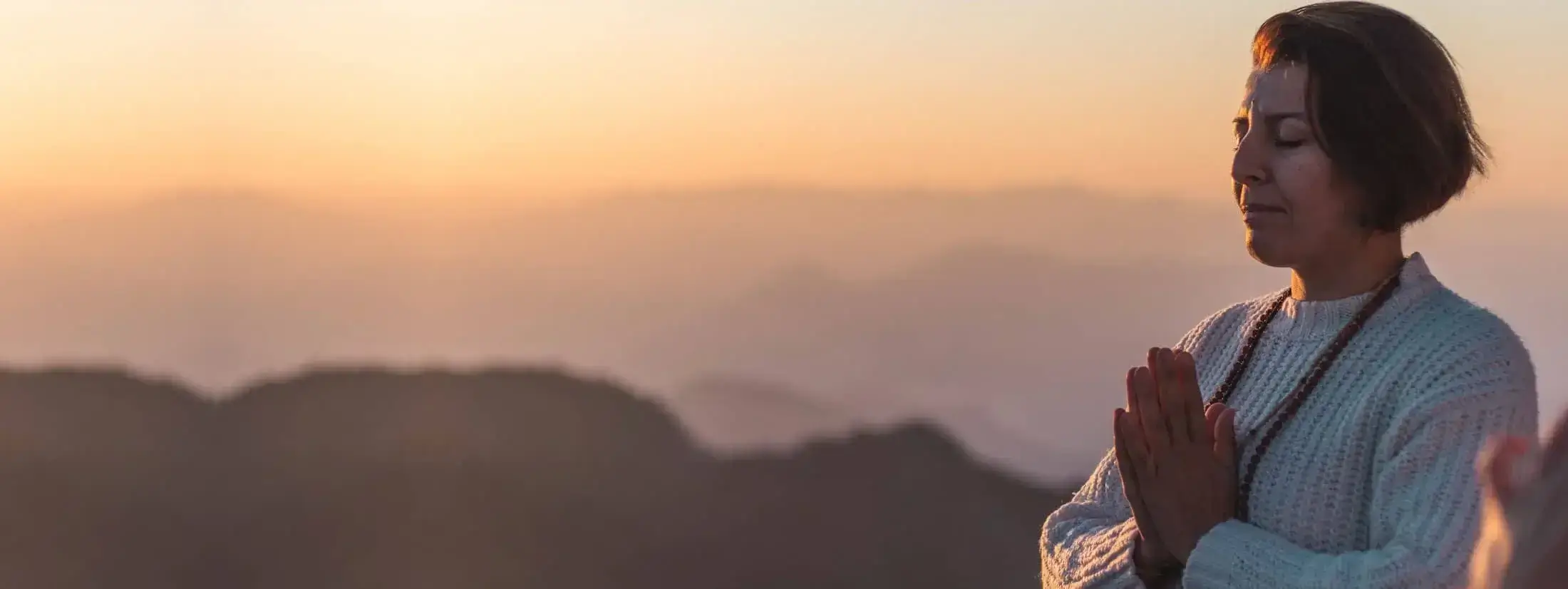
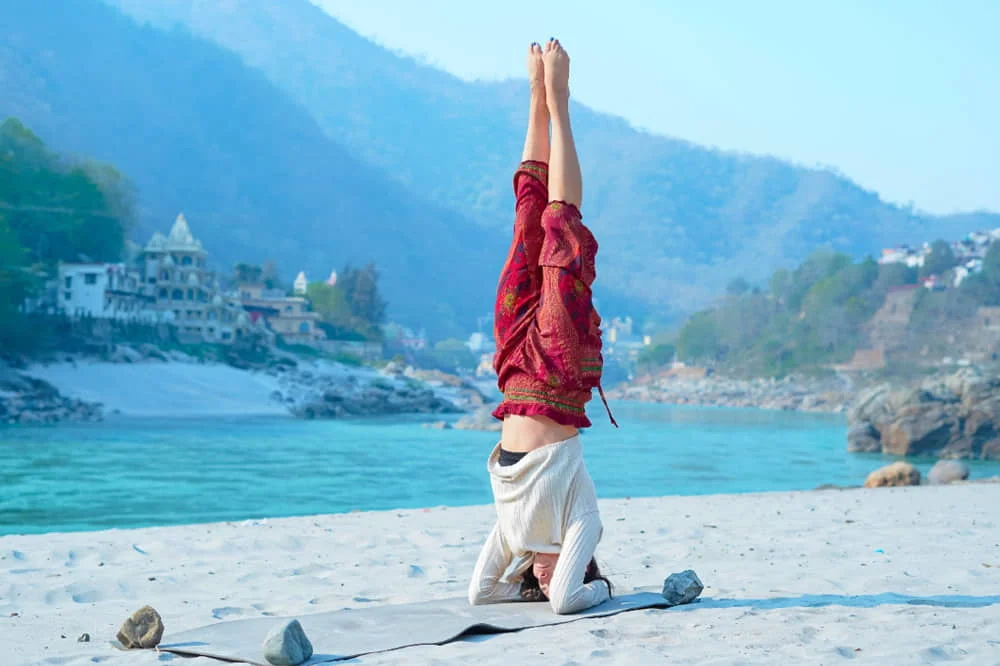
The 300 Hour Yoga Teacher Training Course in Rishikesh is a Residential Advanced yoga TTC course in Rishikesh. who want to learn in-depth Advanced Asana Poses, About yoga anatomy, Yoga philosophy, Ayurveda , Yoga therapy and much more with a holistic approach. The 300 hour Yoga Teacher Training Course in Rishikesh gives an unbelievable experience which not only helps in achieving physical benefits but also relaxes and calms you from inside. This Yoga teacher training in Rishikesh gives mental, physical, emotional, and spiritual benefits.
300 Hour Yoga Teacher Training in Rishikesh is open to all advanced Yoga practitioners. As per Yoga alliance guidance 300 hour yoga teacher training course in Rishikesh is suitable only after completion of 200 Hour Yoga TTC as a certain concept of yoga you may not understand without it . Those Yoga enthusiasts or practitioners, who have been practicing yoga from a long time, can join our advance multi-style 300 hour yoga teacher training course in Rishikesh but not only for the certification in yoga but also with an aim to get advanced insights of yoga to spread it all around the world to transform the lives of others.
On the successful achievement of 300 Hour Yoga TTC in Rishikesh, you will get certified as a yoga teacher with RYT 300 – Yoga Alliance USA, and if already holding the 200 hour certification you will qualify for the 500-hour designation. You can absolutely start yoga teaching as a yoga instructor and be a part of much progressed and well-educated communal at an international level.
This, Yoga TTC in Rishikesh, includes the best combination of both practical & theoretical training of Yoga. It provides for yogis or yoga practitioners with proficient and skilful trainings and build a full of confidence to a yoga trainer. It is a full-bodied yoga course that assists your role into a yoga teacher while providing in-deep insights into yoga and meditation practice
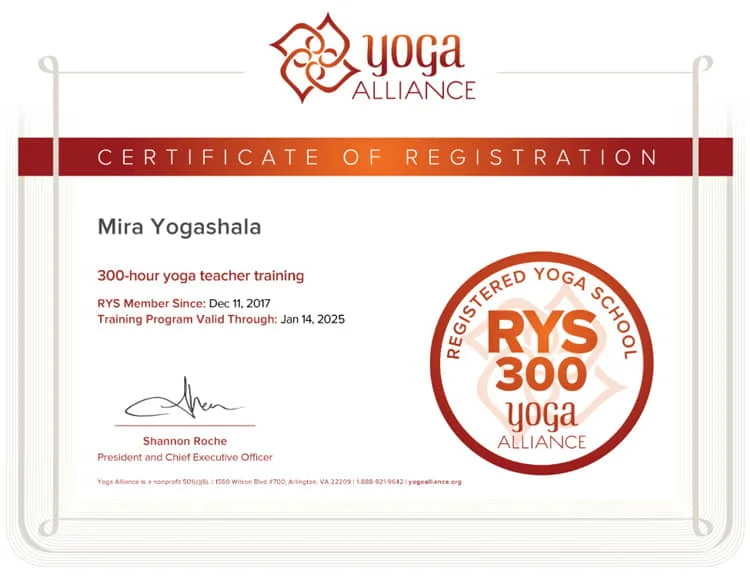
300 Hour Yoga Teacher training Course will help you to advance your Yogic knowledge and to dive more deeper into Yoga, to get more flexibility and strengths. If you are one who is aiming to become a yoga teacher or if you are already a yoga teacher, then this course is perfectly suitable for you. After Successful Completion of 300 Hour Yoga teacher training Course at Mira Yogashala You will be able to teach Yoga Classes with more knowledge and more confidence Because you will have the beginner to advanced yogic knowledge of Theoretically and Practically. And then it's gonna be so easy for you to create unique and beneficial Yoga Lessons plans accordingly for your Students. The More You will dive deep into Yoga the More and better you will understand the yogic lifestyle, and then it will help you to create a more Focused, Balanced and Peaceful relationship with oneself and the People around you.
We are Happy to invite you to the most Transformational journey of Your Life. No Worries, if you are a beginner or an Yogic practitioner, This courses is gonna to help you to Show you your spiritual Path. Our experienced Yoga Gurus gonna help and guide you through Different Types of yoga Subjects and about its branches, techniques, and practices. Our main Purpose is to guide you to perfect your Posture and help you to Accomplish your inner growth.
At Mira Yogashala, you Gonna get the opportunity to Discover your Mystic Skills and find your true oneself. Moreover, you are gonna Know to about the interconnect the mind, body, and soul, which is gonna to help you to encounter this life and its challenges with full energy. Replace all the Stress and depression in your life, with positive Attitude and Calmness, through yoga. Begin your beautiful spiritual journey today, if you want to become a teacher of yoga or learn it for your self improvement. We are absolutely committed to offer you the excellent guidance and support, so that you can reach to your absolute goal. The Mira Yogashala has uniqueness and objective-oriented yoga courses Specially designed for different levels of Yogic practitioners and Students.
We also held Different types of activities throughout the Month During your course, which is includes excursion, Beach Yoga sessions, Ganga Aarti, Himalayas sightseeing, Sound Healing Session, Body Movement Session, and so much more. All of these different types of activities help us to Build a more vibrant and Happy learning Atmosphere.
The environment at Mira Yogashala is cozy, friendly, helping each other, and encouraging each other growth in a supportive Atmosphere. Our Yoga teachers are highly proficient in their Specific Yoga Subject. Because we are located in Rishikesh, which has a very long history with yoga and about it, the connection between yoga and Yoga students strengthens because of the positive energy created around.
It is definitely an Beautiful journey of oneself-discovery and inner growth. We are absolutely sure that the knowledge and experience you gonna get will be invaluable for a lifetime !
The 300 Hour Yoga teacher Training course is Suitable and best for those having a desire to dive deep into yoga as practically and theoretically, its Methods as well as About its Branches. If you are a Beginner you are not eligible to do this course as per yoga alliance guidance, because it is an Advanced Yoga course so you need to complete 200 hour yoga teacher training course first to become eligible for 300 hour yoga teacher training course. If you have already completed a 200 hour yoga teacher training course from any yoga alliance registered school then you are eligible to go ahead and dive more deeper into yoga with our 300 hour yoga teacher training course. you can Expand your yogic knowledge and skills after a 300 hour yoga teacher training course.
This Course is Designed to get you deeper into yoga and the path of Yoga. You will begin in this course from that point where you left ir in 200 hour yoga ttc. You will learn so many new topics such as Advanced Asanas, and yogic breathing techniques in 300 hour yoga ttc, which you even didn't hear about in 200 hour yoga ttc. So come and join us on this spiritual path and learn more about yourself and your soul.
Embark on a comprehensive and life changing transformational Yoga Teacher Training journey at Mira Yogashala, where our curriculum maintains a Rich order of subjects/Topics designed to deepen your understanding and knowledge of the yoga.
 Hatha Yoga
Hatha Yoga
How to Practice Asanas in the Way of Meditative.
 Ashtanga Yoga
Ashtanga Yoga
Be in Flow Your Daily Practice With Ashtanga Vinyasa
 Meditation
Meditation
Heal Your Mind through Meditation
 Pranayama
Pranayama
Learn Different Types of Breathing Technique
 Yoga Philosophy
Yoga Philosophy
Learn About Yoga and its Branches
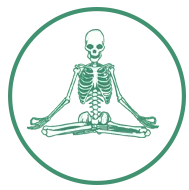 Yoga Anatomy
Yoga Anatomy
Learn About your Body and its parts
 Kundalini Yoga
Kundalini Yoga
know About Kundalini Chakras & its Kriyas
 Mantra Chanting
Mantra Chanting
Be in Peace of Mind with Mantra chanting
 Mindfullness
Mindfullness
Learn how you can be in Fully present in the current moment.
 Relaxation
Relaxation
Learn about How to decrease Stress from your body and mind.
At Mira Yogashala, we're dedicated to providing an intimate and transformative learning experience. We believe in the power of small, focused groups where each student receives personalised attention and guidance from our expert teachers. We keep our batch sizes small, with a maximum of 8 students, Because of our intimate class sizes, spaces fill quickly. Don't miss this opportunity to deepen your practice in a supportive and nurturing environment.
Note: For those seeking spectacular Sunrise view, & mountain view rooms are available for an additional 100 USD.
Every Yoga class is Essential & Important for you to learn and dive deep into yoga. Our Daily 300 Hour Yoga teacher training schedule is Gonna help you to learn and gain the deeper knowledge of Yoga. The daily schedule has been set for students and you have to follow it Accordingly. Attending all classes is mandatory.
6:30 Am - 8:00 Am Ashtanga Vinyasa
8:00 Am - 9:00 Am Pranayama & Meditation
9:00 AM - 10:00 Am Breakfast
10:00 Am - 11:00 Am Kundalini Yoga
11:00 Am - 12:00 Pm Alignment & Adjustment
12 :30 Pm - 1:30 Pm Lunch
2:00 Pm - 3:00 Pm Yoga Philosophy, Ayurveda & Yoga Therapy
3:30 Pm -5:00 Pm Traditional Hatha Yoga
5:15 Pm - 6 :15 Pm Yoga Anatomy
7:00 Pm - 8:00 Pm Dinner
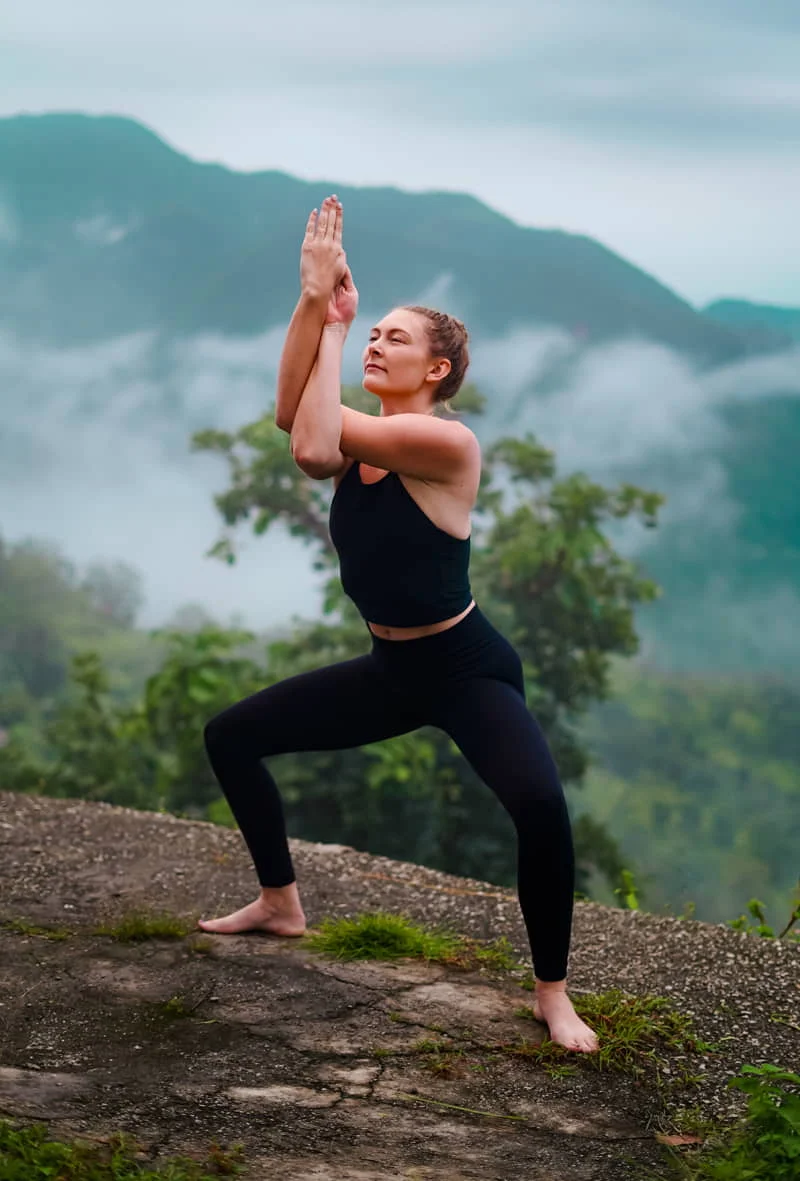
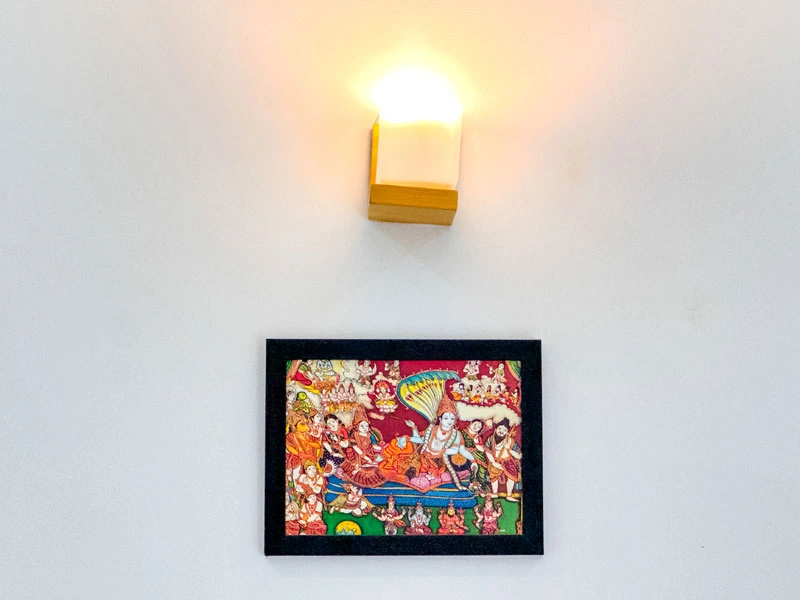

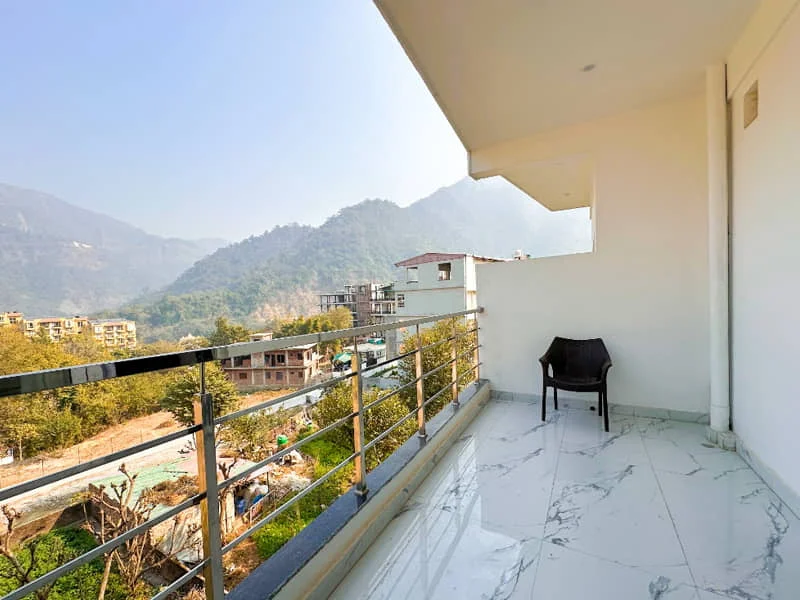
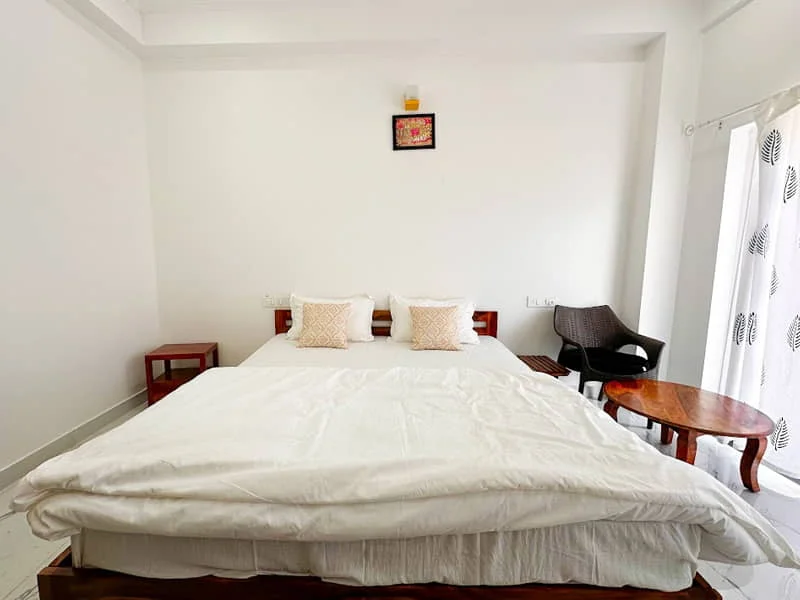





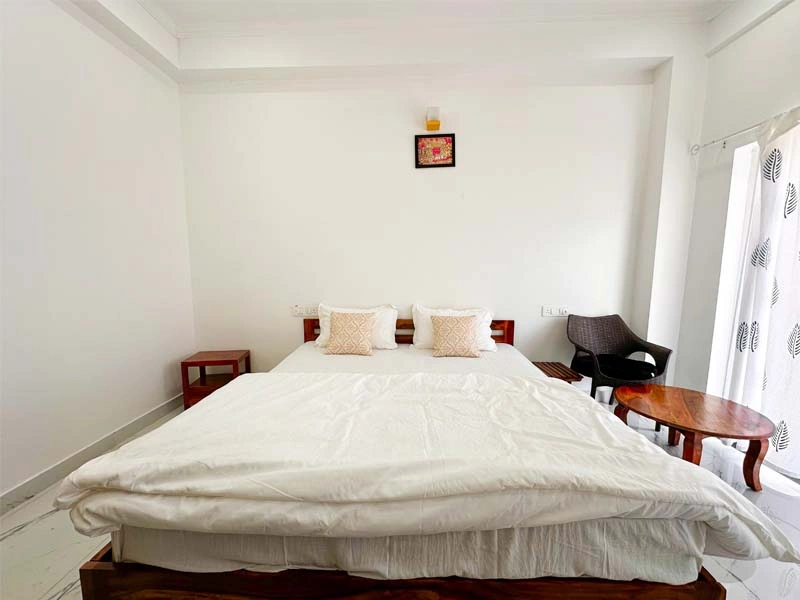


Nestled amidst the breathtaking beauty of the Himalayan foothills, Mira Yogashala offers a sanctuary for those seeking to deepen their yoga practice. Our eco-friendly haven is designed to inspire and rejuvenate, providing the perfect environment to immerse yourself in the art of yogic science.
We offer comfortable and thoughtfully appointed accommodations, featuring neat and clean rooms with attached bathrooms, ensuring a restful and rejuvenating stay. Each room is airy, well-ventilated, and equipped with all the necessary amenities to enhance your comfort.
At Mira Yogashala, we are committed to providing a seamless and supportive experience, ensuring that every student feels cared for and enjoys a truly transformative stay.


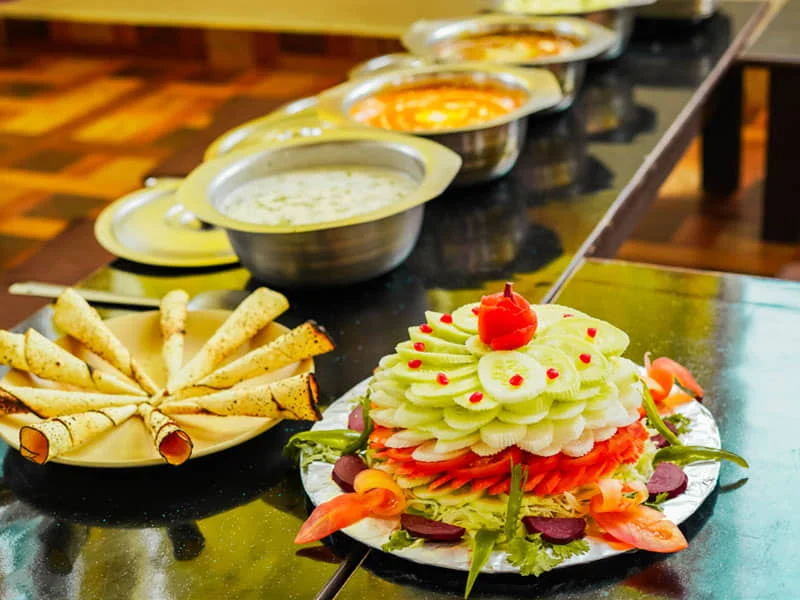
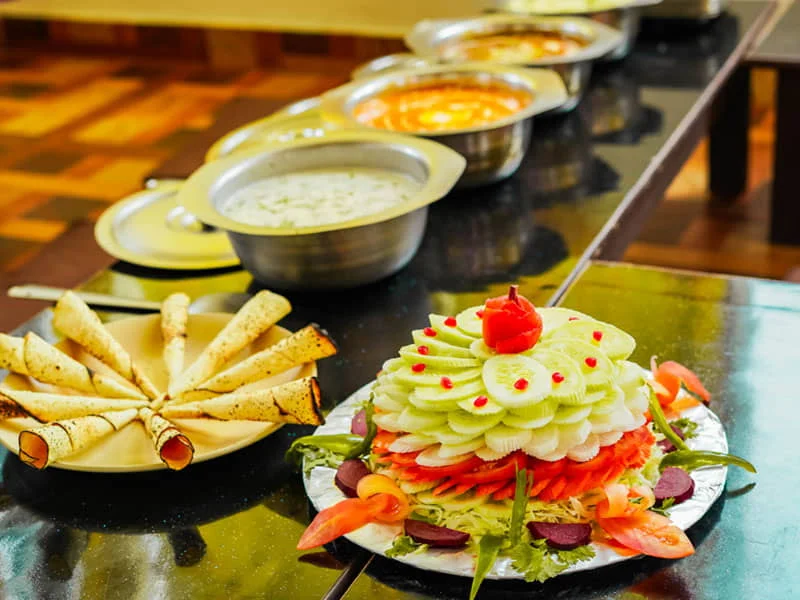









We realize the importance of healthy food and nutrition for yoga practitioners in our Yoga School in Rishikesh. Special attention is given to the yogic nutrients being completely fresh, healthy, and vegetarian. Therefore, you don’t need to worry about healthy food because it is of the best quality, delicious, healthy and vegetarian food to be provided all the time. The menu of food and the eating schedule is set in a better way so that the food which is provided to the students to eat that benefits their body. The trainees of the Yoga Teacher Training Course in Rishikesh will be provided with 3 meals at standard intervals of time with herbal tea in the beginning of the day and at night are given to all our student. The food is completely vegetarian and freshly prepared.
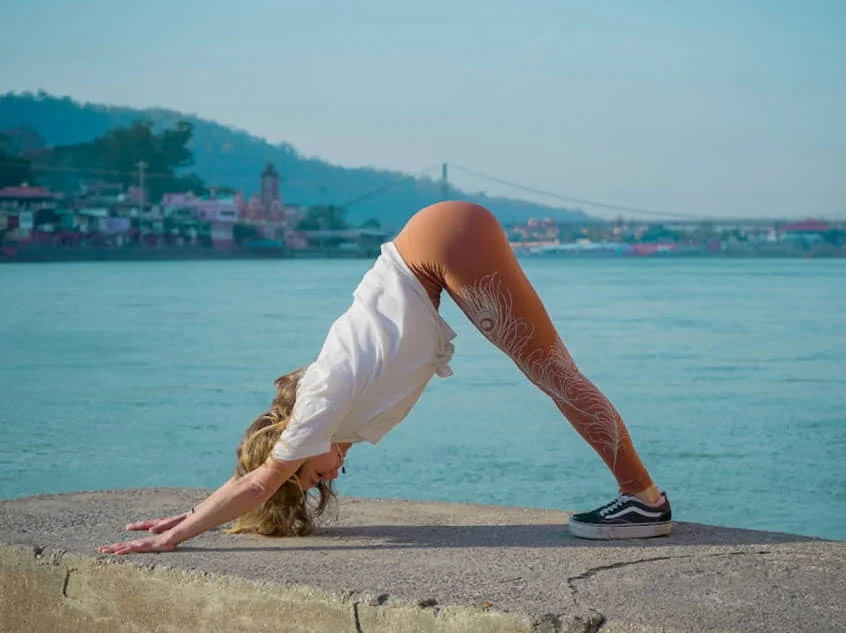
Traditional Hatha Yoga, rooted in centuries-old yogic wisdom, is a holistic practice that unites the physical, mental, and spiritual dimensions. Focused on achieving balance and alignment, Hatha Yoga incorporates physical postures (asanas), breath control (pranayama), and meditation. Hatha Yoga has two parts: 'Ha' means 'Sun,' and 'Tha' means 'Moon.' This yoga brings together these opposite forces. It assists you in building internal and external body strength. Doing this yoga gets your body ready for more advanced practices. It also enables you to focus your energy on bigger goals, like connecting with the universe over time. It is not just a physical exercise; it's a journey of self-discovery and inner exploration. The practice encourages individuals to listen to their bodies, cultivating self-awareness and fostering a deep mind-body connection. Through the regular practice of Hatha Yoga, practitioners often experience increased flexibility, improved concentration, and a heightened sense of overall well-being. Rooted in tradition, this timeless discipline remains a path for modern seekers to find balance, peace, and a profound connection to the essence of life. Whether you are a novice or an experienced yogi, Traditional Hatha Yoga welcomes all on a transformative voyage toward holistic health and spiritual awakening.
In Hatha Yoga, practitioners engage in a series of asanas to strengthen the body, enhance flexibility, and align energy channels. Breath control techniques, or pranayama, are integrated to cultivate vital life energy, promoting a sense of calm and balance. Meditation plays a key role, fostering mindfulness and connecting individuals with their inner selves. Traditional Hatha Yoga offers a profound journey toward physical well-being, mental clarity, and spiritual harmony.
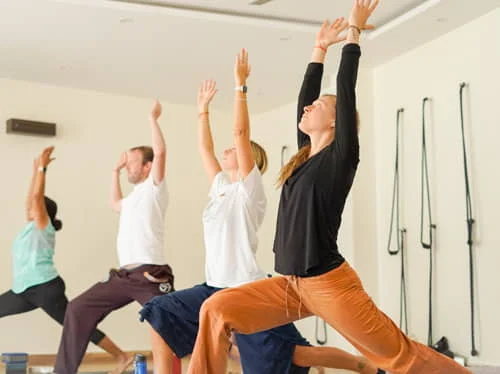
Ashtanga Vinyasa Flow is a dynamic and physically demanding style of yoga that synchronizes breath with movement in a continuous and flowing sequence. Rooted in ancient yogic traditions, Ashtanga Vinyasa Flow is characterized by a set series of poses linked together through a specific breath pattern, creating a dynamic and meditative practice. The practice consists of a series of postures that progressively build in intensity, fostering strength, flexibility, and endurance. The synchronized breathing, known as ujjayi pranayama, adds a rhythmic quality to the practice, enhancing focus and concentration. Ashtanga Vinyasa Flow is often practiced in a Mysore style, where students move through the series at their own pace, guided by the breath and their individual abilities. The flowing nature of the practice creates a moving meditation, promoting a sense of presence and mindfulness throughout the entire session.
The practice of Ashtanga Vinyasa Flow is not only a physical endeavor but also a spiritual and mental discipline. It challenges practitioners to explore the limits of their bodies and minds, fostering a deep connection between breath, movement, and inner awareness. As a comprehensive and transformative yoga style, Ashtanga Vinyasa Flow invites individuals to embark on a journey of self-discovery, self-discipline, and holistic well-being.
Surya Namaskara A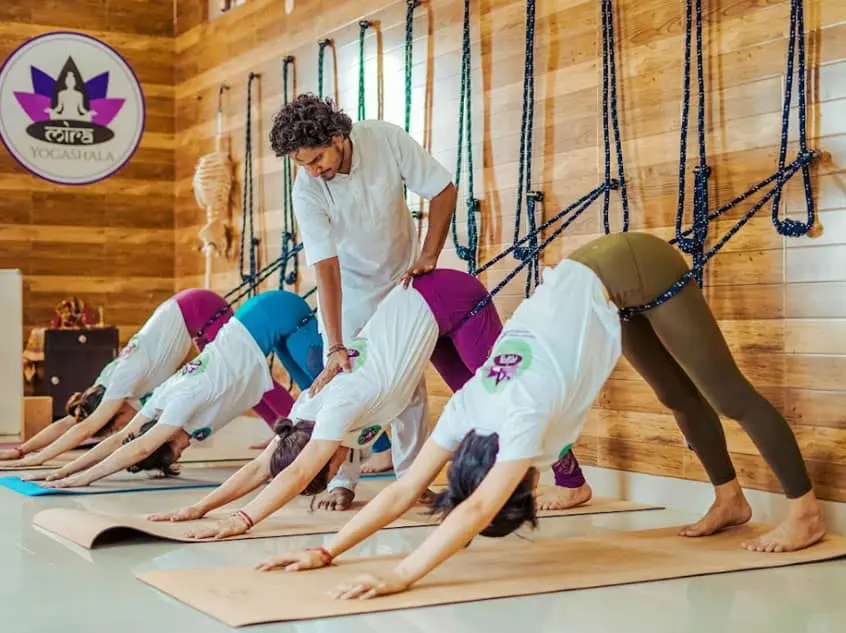
Alignment and adjustment are key concepts in yoga that lead practitioners towards a peaceful and transforming experience. These components ensure that every asana (position) is appropriate from a physical standpoint and meets the practitioner's needs, improving mental, emotional, and physical health. In yoga, alignment is the exact body placement in each asana (posture). Maintaining proper alignment lowers your chance of injury and guarantees that you reap the full benefits of the posture. Alignment and adjustment encompass not only the physical parts of yoga but also its mental and emotional components. Students develop awareness as they synchronise their bodies and minds with the here and now. Modifications can build trust and relaxation by offering a feeling of support and connection. In yoga, alignment and adjustment enable practitioners to safely push their limits, advance their practice, and avoid injury. They hold the secret to releasing yoga's transforming power and enabling practitioners to gain a deep sense of strength, balance, and inner serenity. Becoming proficient in alignment and adjustment methods is crucial for aspiring yoga teachers and students. We assist our students in realising their greatest potential and strengthening their bond with yoga through this art.
Our teachers are qualified to make changes while respecting each person's particular demands and comfort zone. Our method of alignment and modification is based on mindfulness and safety. Practicing yoga should be an intentional, conscious journey in which every pose is executed with awareness and intention. Our students experience yoga as a transforming and healing practice, develop a body-mind connection, and learn to listen to their bodies via skilful alignment and modifications.
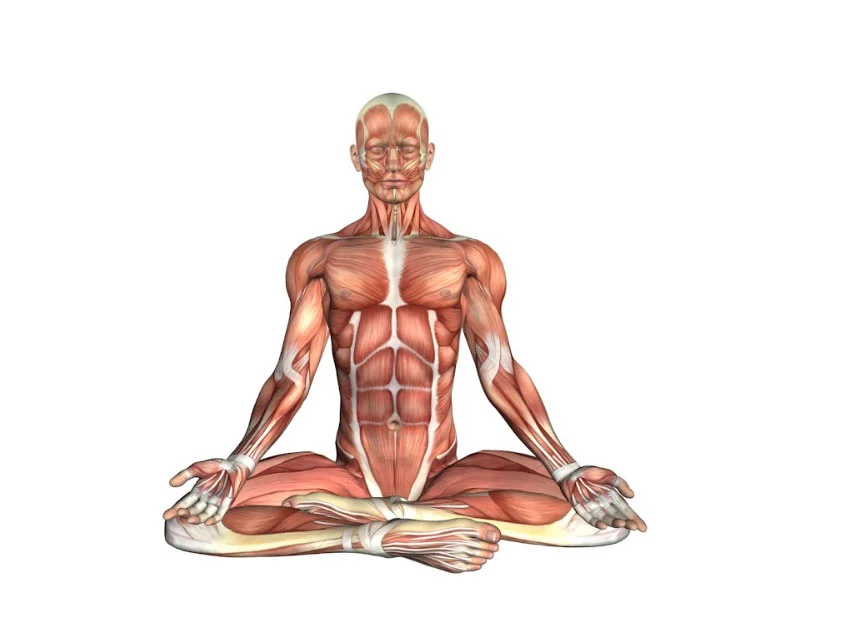
Yoga is a profound path of self-discovery and development, not just a physical exercise. We study the body's inner workings in our yoga anatomy classes, focusing on the muscles, bones, joints, and connective tissues. Students learn about alignment, preventing injuries, and refining their practice by comprehending the interactions between these components during asanas (postures). At Mira Yogashala, the secret to realising the full potential of your practice is to grasp the subtleties of yoga anatomy. Our dedication to yoga anatomy stems from our conviction that understanding the body's mechanics improves the efficacy and safety of your yoga practice. Our importance on individuality is one of our approach's guiding concepts.
Since everybody is different, what suits one individual cannot suit another. Our yoga anatomy lessons enable students to respect the knowledge of their bodies, enabling them to modify poses to fit individual requirements and skill levels. We also close the knowledge gap between practice and theory. Our instructors give a comprehensive grasp of the body-mind link by fusing contemporary scientific knowledge with the wisdom of traditional yoga.
Our yoga anatomy courses also enhance students' overall yoga education by complementing our wider curriculum. We dive into yoga's philosophical and spiritual sides and its physical components, resulting in a comprehensive and engaging learning environment. So, we warmly encourage you to embark with us on this life-changing journey, where yoga anatomy serves as a conduit between the material and the spiritual realms, strengthening your bond with yoga and yourself.
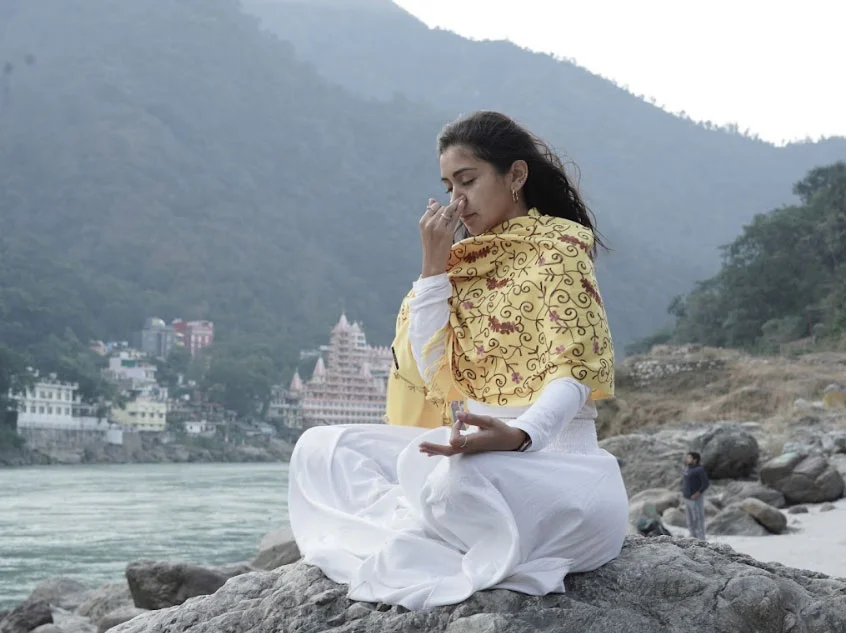
Pranayama Yoga, an integral component of traditional yoga practices, focuses on breath control to enhance the flow of life force energy (prana) within the body. Rooted in ancient yogic philosophy, Pranayama involves conscious breath regulation through various techniques. These may include deep breathing, alternate nostril breathing (Nadi Shodhana), and breath retention. The practice of Pranayama serves multiple purposes, including calming the mind, improving respiratory function, and balancing the subtle energy channels in the body. By cultivating awareness of the breath, practitioners gain a deeper understanding of the mind-body connection. Regular practice of Pranayama is believed to bring about a sense of inner tranquility, increased vitality, and a harmonious balance between the physical and energetic aspects of one's being. As a foundational element of yoga, Pranayama serves as a gateway to profound states of relaxation, mindfulness, and holistic well-being.
Pranayama Yoga invites practitioners to explore the breath as a bridge between the physical and spiritual realms. Through intentional and mindful breathing, individuals can experience a profound sense of inner peace and heightened awareness. The various techniques in Pranayama not only enhance lung capacity but also stimulate the parasympathetic nervous system, promoting relaxation and stress reduction. As an accessible yet powerful practice, Pranayama can be integrated into daily life, offering a tool for managing stress, improving mental clarity, and fostering a greater connection to the present moment. Whether practiced independently or as part of a broader yoga routine, Pranayama serves as a gateway to self-discovery, facilitating a deeper understanding of the breath's transformative potential and its impact on overall well-being.

The term 'Satkarma', which comes from the Sanskrit terms 'sat' (truth) and 'karma' (action), refers to a series of purifying exercises that are part of the yoga tradition. These customs foster harmony and balance by cleansing the body and mind. Techniques like Neti (cleaning of the nose), Dhauti (cleaning of the digestive tract), and Kapalabhati (purification of the breath) are examples of satkarma. The goal of practitioners is to improve their entire state of well-being and spiritual path by purging mental and physical impurities. In addition to purifying the physical body, satkarma also makes way for more in-depth meditation and self-realization, leading people to inner truth and enlightenment. The six purifying methods that make up satkarma each have a distinct function in fostering mental and physical balance. Satkarma purges not only the body but also negativity and clutter from the mind. These techniques clear the body of physical impurities and impediments, fostering a peaceful atmosphere conducive to meditation and self-realization. They promote the unrestricted passage of prana, or life force, which boosts energy and promotes spiritual development. Satkarma is a life-changing path towards holistic well-being and self-discovery. It gives people the ability to transcend their limitations, both mental and physical, and to delve further into yoga and spirituality.
The path of purification, or satkarma, is a sacred practice that opens the door to self-realization and holistic development. So, come along on this life-changing trip with us to awaken your spirit, regulate your mind, and cleanse your body. Discover the significant advantages of satkarma and realize your full potential for a balanced, energetic, and spiritually awakened existence.
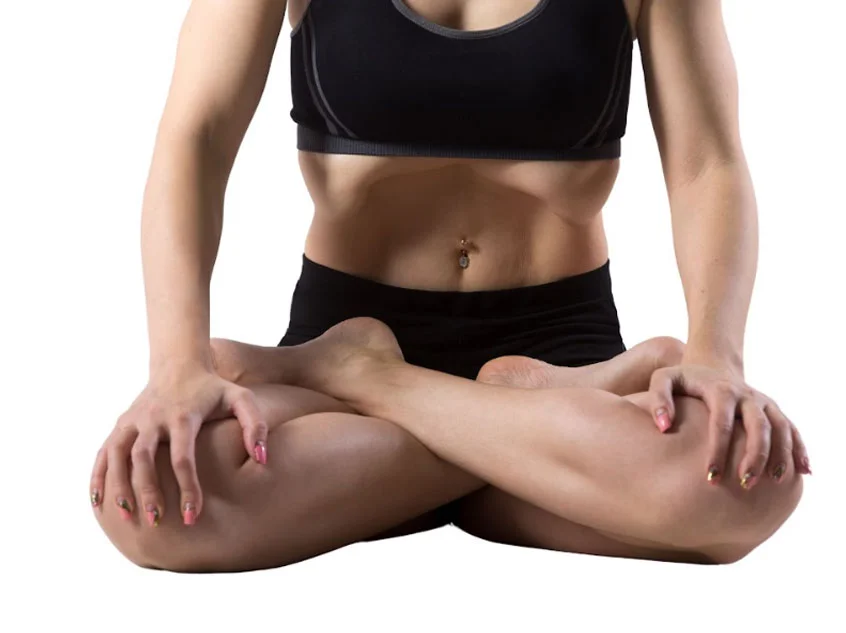
Bandhas, which stand for the subtle art of controlling the body's energy, are essential to practicing yoga. To reroute and control the flow of prana (life force), these energy locks require the contraction of particular muscles. Mula Bandha (root lock), Uddiyana Bandha (abdominal lock), and Jalandhara Bandha (throat lock) are the three main bandhas. When pulled taut, these bandhas aid in the upward channelling of energy up the spine, fostering both spiritual and physical enlightenment. They enhance inner strength, focus, and the body-mind connection, deepening the practice. A profound feature of yoga is bandhas, which enable a more in-depth investigation of the self and the cosmos. Internal energy seals are known as bandhas, which derive from the Sanskrit term 'bandh', which means 'to lock' or 'to bind,' control the passage of prana, the essential life force that permeates our entire body. A necessary part of yoga, these sacred locks lead us to inner awareness, bodily stability, and spiritual enlightenment. It awakens latent energy and grounds the body, improving posture and grounding simultaneously. Asana (postures) and pranayama (breath control) are frequently used in yoga along with bandhas, which are transformational tools. The pelvic floor's Mula Bandha promotes both core stability and the reawakening of the dormant Kundalini energy.
Uddiyana Bandha helps to stimulate inner fire and cleanse the digestive system, while Jalandhara Bandha controls the energy flow to the throat, supporting thyroid function and sharpening concentration during meditation. These subtle practices are crucial components of the yogic path towards self-realization because they can result in significant spiritual growth and an increased sense of energy, but they also require instruction and perseverance.
Jalandhara Bandha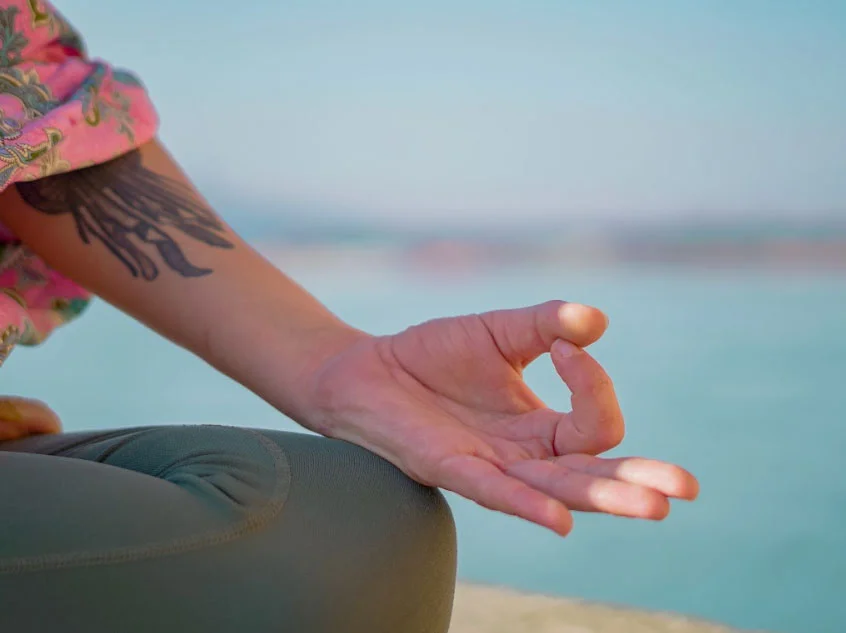
Intricate hand and finger movements known as mudras, which translate to 'gesture' or 'seal' in Sanskrit have great spiritual and cultural importance. In yoga, meditation, and rituals, these symbolic motions are used to direct energy and elicit particular mental states. Every mudra has its own set of advantages. For example, the Anjali Mudra (palms squeezed together) denotes respect and oneness, while the Chin Mudra (thumb and index finger touch) signifies consciousness and intelligence. Mudras improve mental attention and facilitate the passage of prana, or life force, by acting as bridges between the material and spiritual worlds. People can delve further into their inner investigation and spiritual practice by using these exquisite motions. These graceful movements, which combine elements of science and art, enable us to access the energy currents that run through our bodies. Every mudra is a discrete language in and of itself, expressing intents, feelings, and energy. When used in asanas, pranayama, or meditation, mudras are adaptable instruments that improve the yogic experience. The latent forces within us are roused by these spiritual manifestations, leading us to a higher level of awareness. Mudras have several advantages that go well beyond the material world. They balance emotions, reduce tension, and enhance concentration.
Mudras provide us with the ability to access the transforming energies that are inside our own hands. These modest yet practical actions will lead you to a closer relationship with the cosmos and with yourself. Accept the dialogue in silence when using mudras, and allow them to be your key to fully realising yoga's great potential.
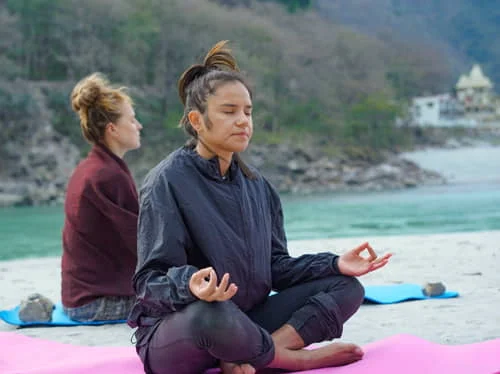
Meditating is a potent exercise that calms the mind and spirit and transcends the stress of our contemporary lives. It's an interior excursion, a mental retreat where tranquilly, clarity, and deep calm can be found. Meditating reduces tension and anxiety by sharpening our awareness through focused breathing and mindfulness. It develops a closer relationship between the individual and the cosmos, promoting emotional equilibrium and personal development. There are many other kinds of this old art, such as transcendental techniques and guided meditations. Whatever one's path, meditation offers a haven from the outside world and opens the door to deep inner peace and enlightenment. Regardless of your experience level, our knowledgeable instructors will lead you towards self-realization and silence. Our knowledge of the mind-body link forms the foundation of our meditation practices. These techniques improve mental clarity and emotional resilience in addition to lowering stress. To assist them in establishing a connection with the cosmos and their inner selves, we urge our students to investigate the spiritual aspects of meditation. Beyond the meditation cushion, there are numerous advantages to meditation. Our pupils report feeling more focused, less anxious, more creative, and more content overall. Meditation is more than just a practice; it's a gateway to a calmer, more purposeful life.
So, come along on this life-changing trip where the age-old practice of meditation meets cutting-edge living to see the significant effects it may have on your mental, emotional, and spiritual health. Accept the calmness inside you, and use meditation as a roadmap to a more harmonic and balanced life.
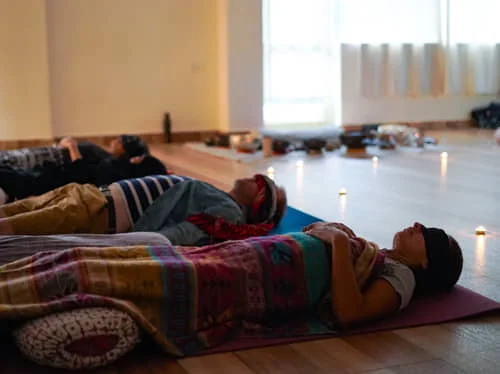
The practice of yoga's relaxation technique emerges as a haven for the body, mind, and soul in the chaos of our hectic existence. Beyond the physical poses and flowing movements, yoga emphasises the significance of experiencing deep moments of serenity and renewal. This fundamental facet of yoga provides a way to achieve emotional balance, inner peace, and overall health. The fundamental pose for relaxation in yoga is called Savasana, or 'Corpse Pose'. This pose, which may seem straightforward, opens the door to deep relaxation. Practitioners of Savasana lie flat on their backs with closed eyes and relaxed limbs. It's an intentional act of giving in to silence. The idea is to let go of mental and physical stress so that the body's natural healing processes can begin. Another foundational element of yoga relaxation is breath awareness. Mindful breathing is encouraged by techniques such as Pranayama, which supports a steady, peaceful rhythm. Inhaling deeply and mindfully helps you feel more invigorated since it lowers stress, anxiety, and increases the amount of oxygen reaching your cells.
Relaxation is a transforming inward journey rather than just a way to escape the chaos. Regularly applying these relaxing methods strengthens general mental and physical well-being, increases resilience, and improves sleep quality. It is impossible to overestimate the benefits of yoga for relaxation in today's environment of constant stress. It provides a haven in the middle of the chaos, a holy place to let go of stress, discover clarity, and foster a closer relationship with oneself. By relaxing, you open up a source of energy and calm that enhances all facets of your life.
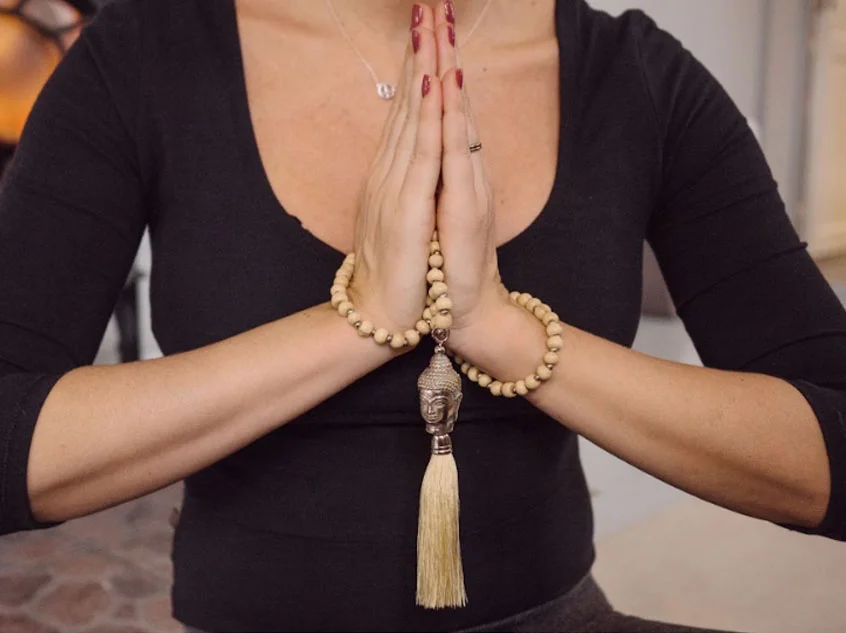
Mantras are an important part of your yoga practice. In 300 hr Yoga TTC, You will be learning about single word mantras, phrases and sentences. Most of the mantras have come up from Sanskrit and your teacher will also teach you the meanings of each one, in English. They are made in such a manner, so that they can communicate with the universe. You can also call them affirmations. They have the power to vibrate with the frequencies of the universe. When you practice mantra chanting regularly, they are ingrained in your consciousness. Mantras have a very important role to play in the realm of Tantra Yoga as well. Mantras mainly act as a tool to stop the mind from getting distracted, while practicing yoga. They can give your mind, proper direction and focus. You will also learn, how to set intentions before starting the yoga class. Mantras can also help you to develop feelings of gratitude. As a part of the course, you will learn how to recite them at a proper time, so that you can connect with the divine.

Yoga philosophy is the Subject where you learn about the philosophy of life. Just by deep understanding of it meaning can change our life. The Routine practice of yoga in physical forms, like with the assistance of asanas, is essential. You also need the theoretical knowledge about the the meditation, Pranayama, kriyas, bandhas, mudras and much more. That is where Yoga Philosophy comes, a crucial aspect of yoga education. You will learn about the various types of Topics in philosophy. Under the realm of yoga, Samkhya Philosophy acknowledge a lot of importance. Then there are Vedanta, Uttara, and Yoga. Our Philosophy teacher will help you to understand the Meaning of yoga in daily life and its uses. so that you can Share the Same knowledge to your students. When you learn about the various types of texts that back your daily yoga practice, you will become more conscious, and spiritually. You will also learn about the Hatha Yoga Pradipika, Patanjali’s Yoga Sutras, and Upanishads as a part of the modules under Philosophy during your 300 hours yoga teacher training in Rishikesh. You gonna also learn about that the body, mind, and the soul are not the separate entities.
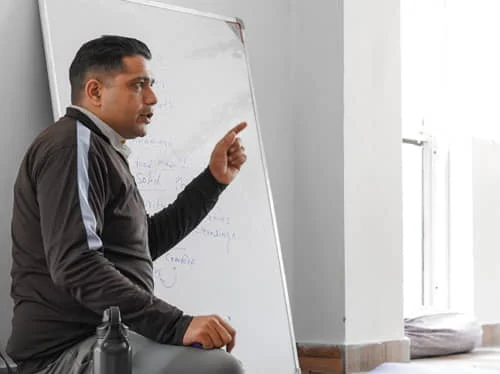
Yoga is a way of life that promotes physical, mental, and spiritual well-being rather than merely a physical activity. The art and science of effectively and captivatingly transferring knowledge and skills to learners is known as teaching methodology. It includes the different methods, approaches, and strategies teachers use to help students learn. It is recognised that yoga can have significant effects on a person's life, and our distinctive style of instruction is intended to enable our students to become outstanding yoga instructors. Our approach to teaching explores the art of teaching itself, going beyond the poses and mudras. Along with the physical postures known as asanas and hand gestures known as mudras, our curriculum also covers anatomy, philosophy, pranayama, and meditation. As a result of consistent practice, they develop a thorough comprehension of the asanas and mudras, enabling them to instruct confidently and sincerely. Since each student is different, the teaching approach gives graduates the tools to modify their instruction for various learners and contexts. Beyond graduation, this sense of community builds a network of like-minded people committed to spreading the advantages of yoga.
The comprehensive and distinctive teaching methodology is used in yoga training. By emphasising teaching techniques, flexibility, and community building in addition to the physical aspects of yoga, we equip our students to become excellent yoga instructors who can genuinely impact their students' lives. It recognises that every person has a different learning style and adjusts to meet their varied needs. In the end, a skillfully designed teaching approach enables pupils to succeed both in the classroom and beyond.

Yoga therapy uses the age-old knowledge of yoga to treat mental, emotional, and physical imbalances. As a highly individualised type of therapeutic intervention, yoga therapy differs from typical yoga classes in that it customises practices to match each individual's unique needs and situations. Fundamentally, yoga therapy acknowledges the connection between the body and the mind. It seeks to treat the underlying causes of discomfort or illness to restore harmony and balance. Yoga therapists collaborate extensively with their patients, thoroughly evaluating their lifestyle, mental and physical well-being, and physical condition to develop personalised therapy regimens. Yoga treatment incorporates a variety of methods, such as deep relaxation, meditation, pranayama (breath control), and asana (physical postures). These procedures are adjusted and changed to meet each person's particular needs. A client suffering from anxiety would benefit from mindfulness meditation and breathing exercises, whereas someone with persistent back pain might benefit from a series of mild stretches and strengthening exercises. Numerous health issues, such as chronic pain, stress, anxiety, depression, sleeplessness, and even long-term illnesses like diabetes and hypertension, have been shown to benefit from yoga therapy. It provides an integrative and supplemental approach to traditional medical care, frequently minimising the need for medication or surgery.
Yoga therapy offers a haven for self-discovery, healing, and development in a society where life's pace is frequently too fast. To attain ideal health and well-being, it supports the person's inner resources and respects their intrinsic ability for healing. Yoga therapy is becoming increasingly recognised as an integrated and holistic technique that may help people live a balanced and harmonious existence.

Ayurveda, also known as the 'Science of Life', is a traditional medical system promoting health and well-being for more than 5,000 years. This all-encompassing healing method has its roots in India and is based on the notion that balance is essential for good health. The fundamental tenet of Ayurveda is that every human is distinct and that each person's constitution, or 'doshas', impacts their health. Vata (air and space), Pitta (fire and water), and Kapha (earth and water) are the three primary doshas. Ayurveda offers tailored advice on diet, lifestyle, and herbal medicines based on an individual's dosha and current level of balance. Fresh, organic foods suited to each person's dosha are emphasised in Ayurvedic cooking, improving digestion and general health. Medicinal plants and herbs are also used in Ayurveda to treat various illnesses. Maintaining mental and emotional stability requires engaging in practices such as yoga, meditation, and mindfulness. Panchakarma is an Ayurvedic treatment that deeply rejuvenates the patient by cleansing the body and mind.
Ayurveda's comprehensive philosophy includes preventive healthcare. Through the detection of imbalances prior to their development into illnesses, Ayurveda enables people to take proactive measures towards long-term health. Ayurveda continues to be an ageless and priceless resource in a society where modern medicine is taken more and more seriously. Its emphasis on natural treatments, balance, and individualised care is still appealing to people who want a comprehensive approach to wellness. Ayurveda provides a road to vigorous health, self-awareness, and a happy life in harmony with the cycles of nature, not merely the absence of sickness.
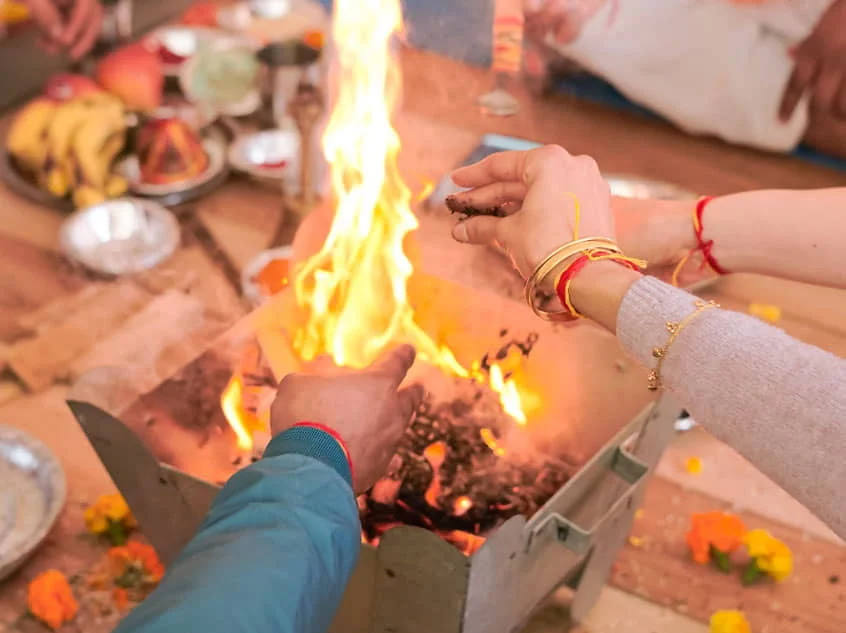
The Fire Ceremony or 'Havan', heralds the auspicious beginning of a student's life-changing yoga journey. This holy rite, which has its origins in old Indian tradition, represents negativity removal and cleansing. On the first day of their yoga inaugural ceremony, students gather around a gorgeously decorated fire pit under the guidance of Priest as the sun rises. Chanting Vedic mantras to invoke the blessings of the almighty opens the ceremony. As a sign of their submission to the spiritual path, participants offer grains, ghee (clarified butter), and aromatic plants to the sacred fire. Radiating warmth and good vibes, the flames dance in various brilliant hues.
The Fire Ceremony sets the tone for the yoga programme and is more than just a ceremony. It represents cleansing the body, mind, and spirit, enabling trainees to approach their practice with fresh eyes. A feeling of harmony and peace descends upon everyone in attendance amid the gentle chants and crackling fire, establishing a peaceful start to an enlightening experience at Mira Yogashala.
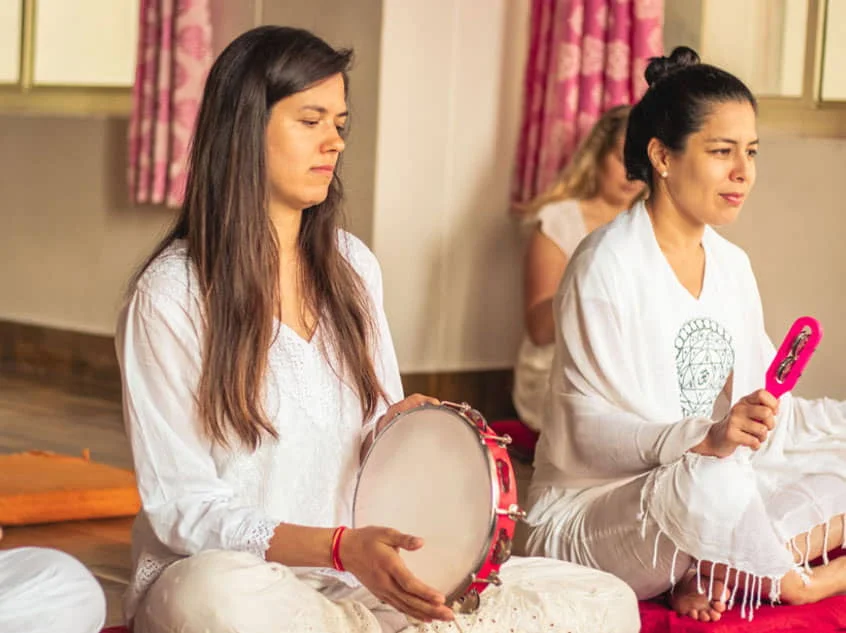
Discover the spiritual resonance of during our 'Kirtan Session' at Mira Yogashala, where you can feel your spirit lifted and your connection to the divine strengthened by the uplifting strains of devotional songs and bhajans. This holy ritual is a sincere journey of physical, mental, and spiritual purification. Through the devotional chanting of kirtan, you can achieve a profound level of inner serenity and spiritual connection beyond language and cultural boundaries. Harmonious vibrations purify your thoughts and emotions as you chant and sing along, giving you a sense of harmony and oneness with the divine. Our Kirtan instructors will be guiding you through this lovely practice. The moving words and captivating melodies evoke a sense of joy and reverence while beckoning you to discover a higher plane of inner harmony.
kirtan's potency comes from its capacity to purify the intellect, open the heart, and create a strong spiritual bond with the divine. you will experience divinity and blissful feeling through our Kirtan Sessions. and it allows the uplifting music to take your yoga practice to new levels of spiritual awareness.

Take advantage of our unique 'Sunrise View Excursion' with Mira Yogashala to witness the enchantment of dawn. Located in the middle of peace, our yoga TTC allows you to experience a spiritual awakening while seeing the earth come to life. We take you to specially selected vantage spots as part of our yoga training so you can enjoy the beautiful dawn views. You will be taken to a serene and amazing world as the Himalayas are illuminated by the first light of the day. The soft tones of the rising light create a captivating palette in the sky, enveloping everything in a cozy, golden warmth.
This sunrise adventure awakens your senses and cultivates a profound sense of appreciation and mindfulness. It's a peaceful time that serves as the ideal introduction to your regular yoga practice. For greater experience, we also conduct meditation sessions for our students to experience the sunrise view. Seeing the sunrise with Mira Yogashala is a potent spiritual experience that creates a peaceful atmosphere for your day and your yoga practice. A crucial component of your life-changing yoga training, our Sunrise View Excursion invites you to join us in savoring the beauty of every new day.
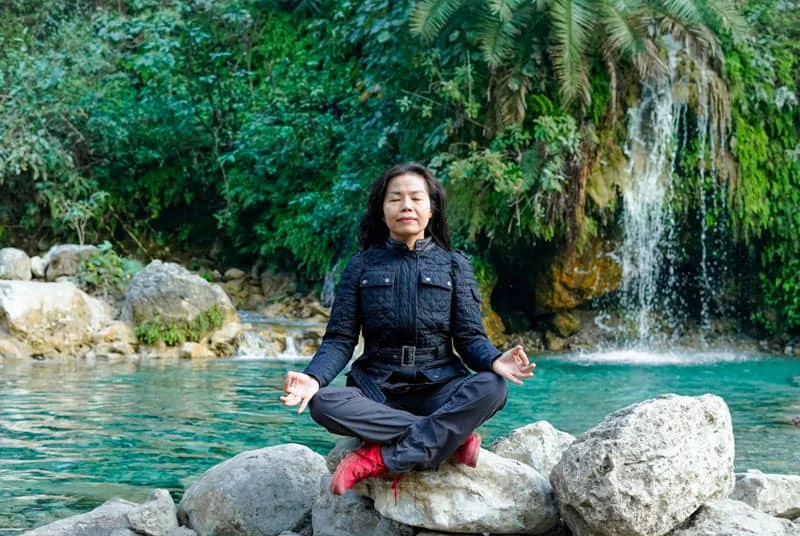
With an exhilarating 'Waterfall Hiking' adventure with Mira Yogashala, uncover the hidden gems of nature. As part of your exotic yoga Course, we take you on a journey to the neighbouring breathtaking waterfalls like Neer Waterfall, Patna Waterfall, or Secret Waterfall and many beautiful waterfalls in the surrounding area. allowing you to connect with the untouched grandeur of the Himalayas. The hike to these waterfalls is an exploration of the senses and a spiritual journey in addition to a physical one. A peaceful environment for introspection is created by the soothing sound of the cascading water, the refreshing mist on your skin, and the serene surroundings.
Trekking to these waterfalls offers a rejuvenating diversion from your yoga routine and a unique chance to connect with the natural world. It serves as a reminder that exploring the outside world can enhance the interior journey. We at Mira Yogashala think that these encounters significantly improve your yoga practice by helping you connect with the natural environment and your inner self on a deeper level.

Experience the perfect balance of energy and calm with our alluring 'Beach Yoga Sessions' with Mira Yogashala. We provide an enchanted environment for yoga practice that invigorates the mind, body, and spirit in the tranquil embrace of the holy River Ganga. Imagine the golden beach beneath your feet, the softly crashing waves as your background, and the orange and pink hues of the rising sun painting the sky. Our beach yoga classes feature a range of techniques, such as Hatha, Ashtanga, and walking Meditation, all of which are intended to tap into the profound energy of this hallowed space. The calming sounds of nature and the river's rhythmic flow transform your yoga practice into a peaceful voyage of inner harmony and self-discovery. Your method gains an additional spiritual dimension from being close to the Ganga, strengthening your relationship with the divine.
It is assumed that doing yoga by the river creates a unique harmony between the natural environment and your inner vitality. It's a life-changing occasion that strengthens your practice and gives you a boost of energy. So, experience yoga on the beach with us, where the holy river and yoga practice will enhance your spiritual development.
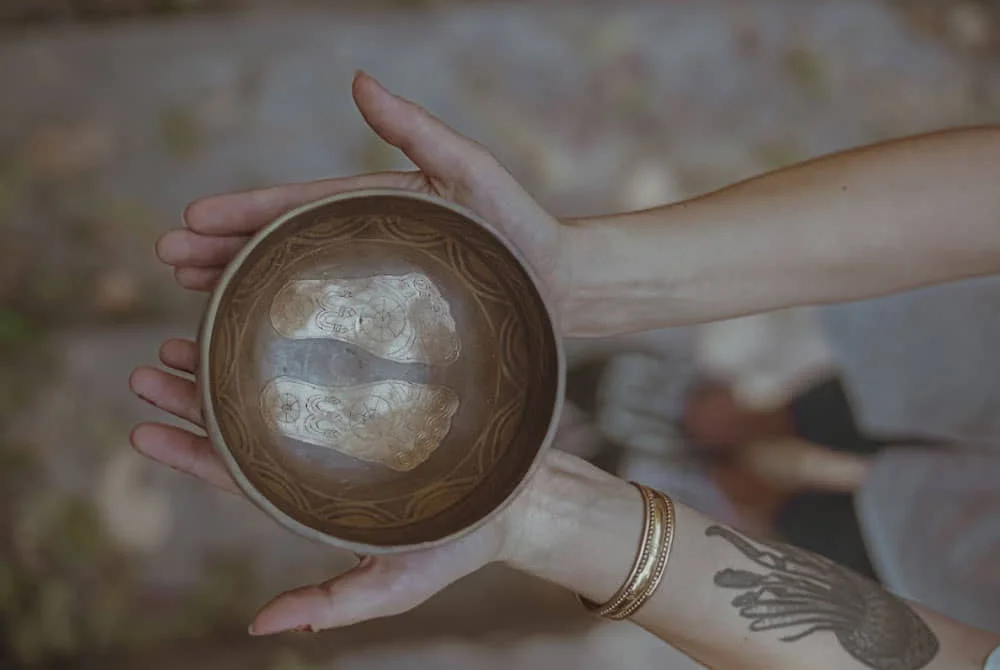
We recognise that the calming vibrations of our "Sound Healing Session" can occasionally pave the way towards inner serenity. These classes are carefully integrated into our yoga curriculum to offer a haven for people who are anxious or restless and are looking for peace. An age-old technique called 'sound healing' uses sound waves to balance the body, mind, and spirit. Our adept practitioners produce a symphony of healing sounds with the resonance of Tibetan singing bowls, crystal bowls, and other sacred instruments. Stress melts away as the soothing tones envelop you, and a deep sensation of serenity takes hold.
This all-encompassing experience enhances your yoga practice by enabling you to let go of stress and achieve a profound state of relaxation. It serves as a subtle reminder that healing can take many different forms and that at Mira Yogashala, we are dedicated to promoting your physical and mental well-being. So, experience a sound healing session During your Yoga TTC and let your yoga practice be guided by peaceful music.
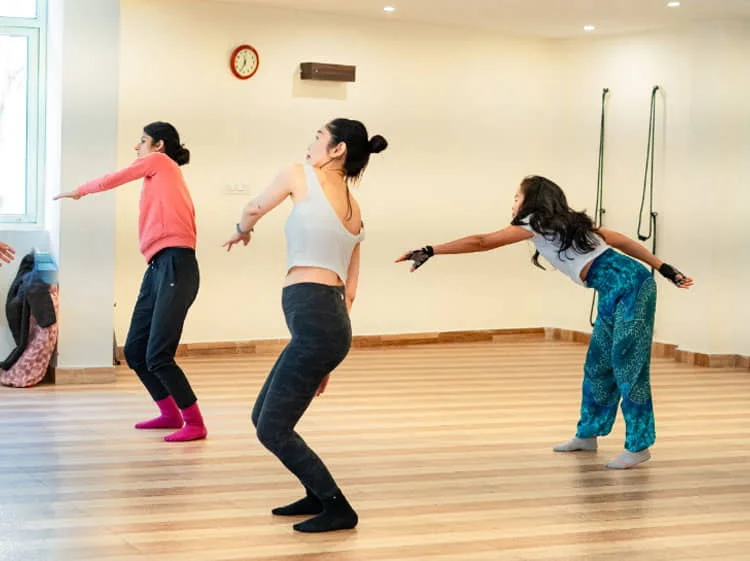
Discover the transforming potential of your body through our 'Body Movement Session'. which are intended to improve your yoga practice while relieving mental and physical stress. These classes combine mindfulness with exercise in a fluid way, providing a comprehensive approach to well-being. Our Body Movement Session features a range of activities, such as, dance, body movement, capoeira dance, and mindful stretching, all taught by experienced instructors. You're encouraged to release tension and tune with your breathing pattern through these flowing motions. It's an elegant investigation of the body's strength and flexibility possibilities. These sessions are excellent because they help people release stored-up stress, improving mental and emotional equilibrium. We provide a thorough stress-reduction toolset by fusing yoga with physical activity so you may approach each practice with mental clarity and serenity.
At Mira Yogashala, we think that the secret to a successful yoga practice is balancing the body and mind. So, experience the profound advantages of holistic well-being and stress release with us at our Body Movement Session on your journey to self-discovery.

As a haven for authentic yoga learning, we believe in nurturing the whole individual – body, mind, and spirit. Now, alongside deepening your yoga practice and knowledge, you can embark on an exhilarating journey into the heart of Indian dance.
Our Bollywood dance session offer a unique opportunity to learn captivating choreography, express yourself through rhythmic movements, and unleash your inner Bollywood star! Imagine yourself moving to infectious beats, surrounded by fellow yogis, all while immersing yourself in the rich cultural tapestry of India. This dynamic addition to our TTC program seamlessly blends traditional yoga wisdom with the joy and excitement of Bollywood. Deepen your understanding of asanas, pranayama, and yogic philosophy, while simultaneously experiencing the exhilaration and cultural richness of Indian dance.
Connect with fellow yogis through laughter, music, and shared movement, fostering a strong sense of community and camaraderie. Our Bollywood dance session are thoughtfully designed to complement your yoga journey, promoting physical fitness, emotional expression, and cultural immersion.
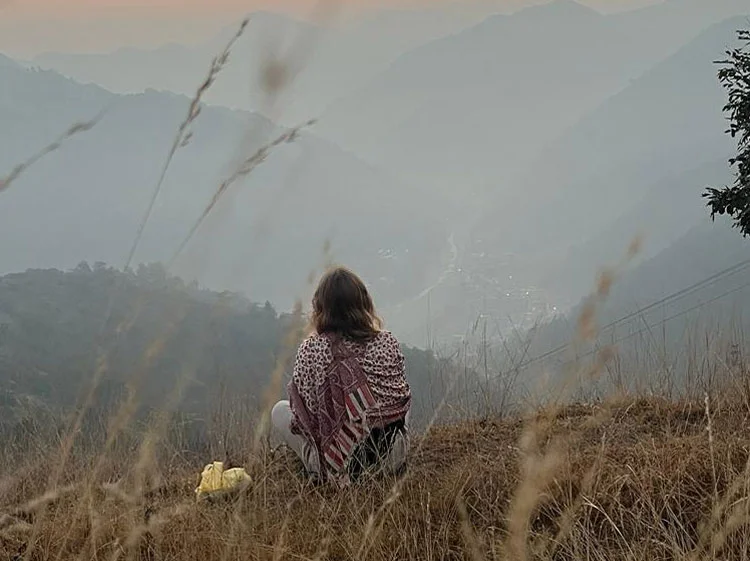
Take advantage of 'Himalayas Sightseeing' tour with Mira Yogashala to set out on a fantastic exploring journey. Our yoga sessions, tucked away in the spectacular Himalayas' foothills, provide a unique chance to take in the breathtaking views from Kunjapuri temple, Balkumari temple, Surkanda devi temple, Chandrabadni temple. We encourage you to experience the tranquility of these Himalayan jewels as part of your life-changing yoga programme. Kunjapuri offers a tranquil setting for introspection and devotion with its tall peaks and verdant valleys. On the other side, Balkumari provides a peaceful retreat into untainted nature where you may unwind and take in the serene surroundings. Since the Himalayas are considered a sacred area, our sightseeing tour is both a beautiful treat and a spiritual adventure. It instils awe and humility by serving as a reminder of the vastness and magnificence of the natural world.
connecting to the Himalayas and nature enhances your yoga practice. So, come along on this tour of the Himalayas with us, and allow the awe-inspiring magnificence of these mountains to ignite your spiritual awakening.
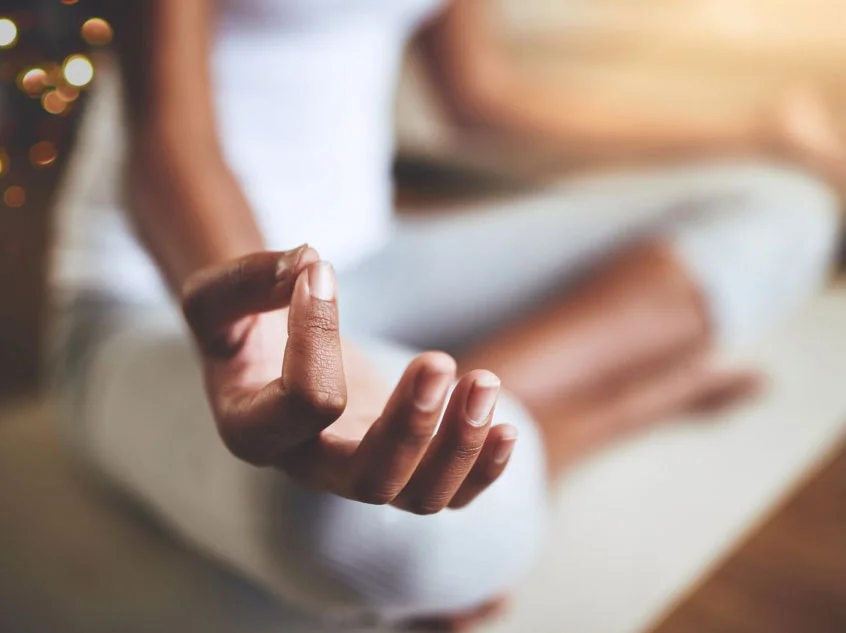
It's essential to nurture the spirit of joy and friendship in addition to the physical body. For this reason, we've added 'Mindfulness Sessions' to our Yoga Course, which are meant to add some spice and joy to your yoga practice. Our mindfulness sessions combine interactive activities, games, and yoga in a fascinating way. They provide a much-needed diversion from the daily grind and foster camaraderie and fun. These carefree times, whether they are spent in a group meditation in the outdoors or playing a friendly game of yoga charades, revitalize the soul. We recognise that taking a multifaceted approach to well-being entails taking care of the body, mind, and heart. We've carefully chosen our mindfulness sessions to ensure that you never get bored while doing your yoga practice.
Joy and laughter at Mira Yogashala are fundamental components of overall well-being. Experience our mindfulness session, and allow the joy and camaraderie of the practice to boost your yoga journey, creating an incredibly enriching and unforgettable experience.
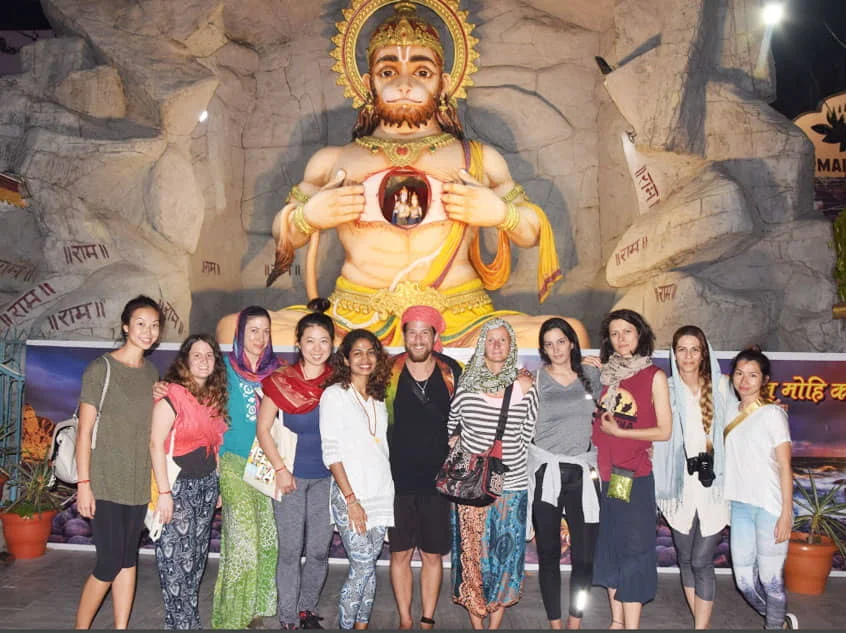
Our 'Ashram and Temple Visiting' expedition to embrace spirituality and history. As a fundamental component of our yoga curriculum, we warmly welcome you to visit hallowed ashrams and temples throughout Rishikesh to establish a deeper spiritual connection. These tours present a singular chance to explore the rich historical significance of these hallowed places while also seeking the divine's graces. Entering historic ashrams, where yogis and sages have sought wisdom for years, will envelop you in a tranquil and reflective atmosphere. Conversely, temples are thriving centers of worship and culture. It is a singular sensory experience, enhanced by the elaborate architecture, captivating ceremonies, and tangible feeling of religion.
These excursions offer an opportunity to get deeper into yoga's spiritual core beyond just cultural research. It serves as a reminder that yoga is a complete spiritual journey rather than just a set of poses. explore the sacred energy of Ashrams and temples, and allow them to inspire your yoga practice and spiritual development.
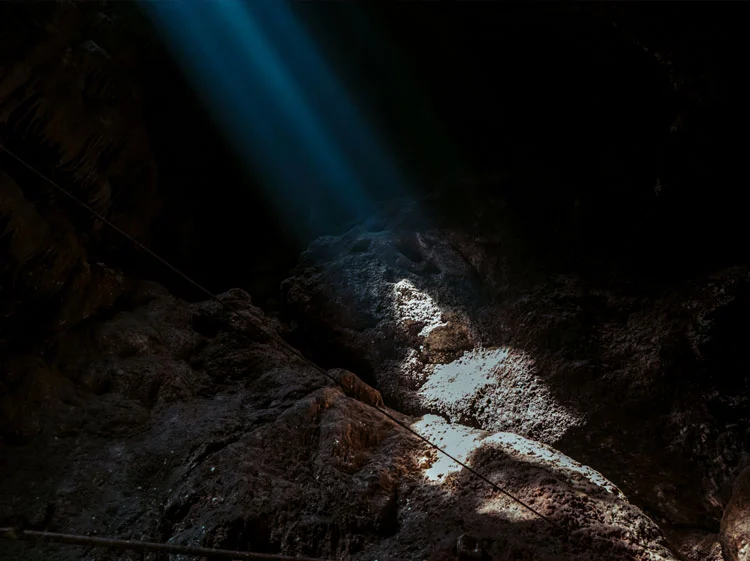
Our exciting 'Cave Exploring' excursion offers an exciting voyage of discovery to oneself. We take you on a tour of some of the most fascinating caves in the area as part of our immersive yoga programme, including the well-known Jhil Mil. cave and Vashistha Meditation cave. These gem places offer an exceptional chance to explore nature's lesser-known treasures. With its deep passageways and historic rock formations, Jhil Mil Cave beckons you to discover the earth's mysteries. The mythologically significant Vashistha cave provides a calm haven for reflection and meditation. Exploring caves is a voyage of self-discovery and a way to connect with the ancient knowledge of the earth, not just an adventure. The serene atmosphere created by the chilly, darkly lighted spaces is ideal for introspection and mindfulness.
enhance your yoga practice by drawing you nearer to nature and encouraging a stronger bond with your inner self. So, join our yoga ttc and explore these meditation caves with us and allow your spiritual journey to be inspired by the mysteries of the earth.

Every student's birthday is a treasured and respected occasion at Mira Yogashala. Since we consider every day a priceless gift, we take great delight in honoring the birthdays of our students with the highest dignity and respect. Our 'Student Birthday Celebration' is a sincere illustration of the close-knit community we promote. We gather together to celebrate this beautiful day with energy and genuine warmth. We ensure our students feel genuinely valued by organizing events like cake-cutting ceremonies and pleasant surprises. It's a way for us to show our appreciation for your confidence in us and to remind you that you are more than simply students. Your trip with us will be remembered for the friendships and camaraderie you made along the road and your physical and spiritual improvement.
It is an honor for us at Mira Yogashala to celebrate our students' birthday, and we look forward to making special memories that express our love and thanks to each and every one of our students. So, come along with us and let's make your special day unforgettable.
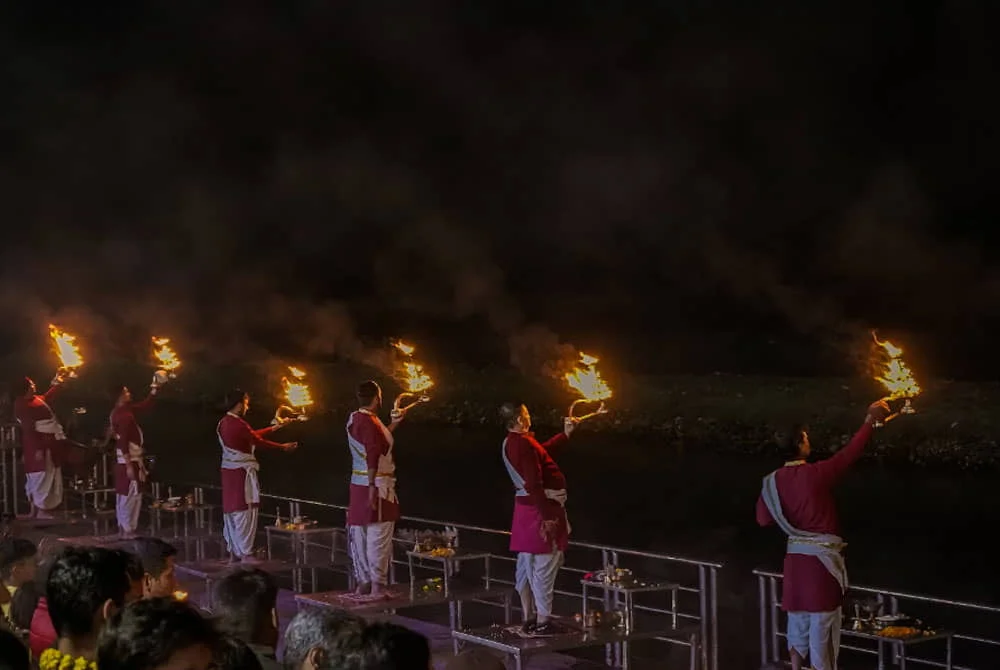
The Ganges River is the holiest river in Hinduism, and the Ganga Aarti is a sacred ceremony of adoration dedicated to it. Every day, this ancient custom is carried out at several Ganges ghats or steps that descend to the riverbanks; however, Varanasi, Haridwar, and Rishikesh host some of the most renowned and beloved rites. There are various reasons why the Ganga Aarti is so important. First and foremost, it is an expression of love and thanks to the Ganges, which is revered as the physical manifestation of the deity Ganga. Hindus hold that taking a bath in the Ganges purges sins from the soul and results in spiritual redemption. Second, the Aarti highlights India's intense spirituality and is a visually stunning event for residents and visitors. An ethereal atmosphere is created that is unforgettable by the mesmerizing dance of lamps, the rhythmic chanting, and the scent of incense.
The Ganga Aarti also serves as a reminder of how intertwined nature and people are. It highlights the importance of protecting the environment and treating this life-giving river with reverence. The Ganga Aarti, which represents this holy river's spiritual, cultural, and ecological significance in the hearts of millions, is fundamentally a powerful statement of faith, appreciation, and reverence for the Ganges.
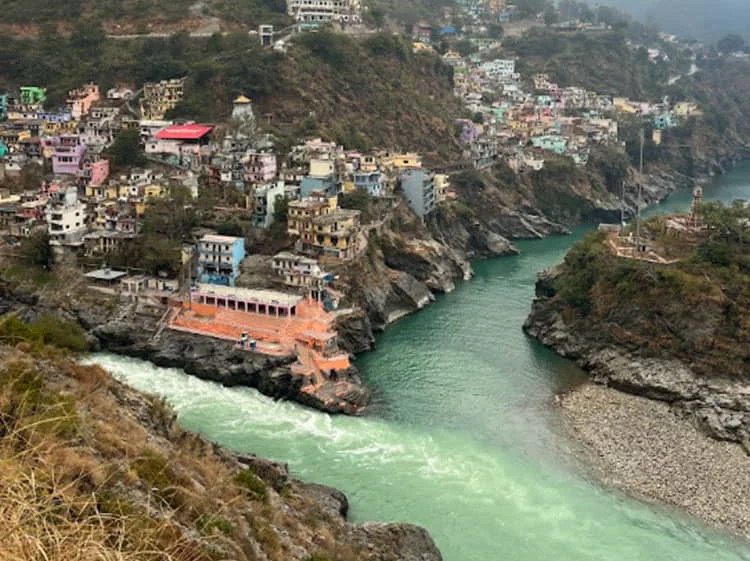
Tucked away in the scenic place, and 70 Km far from Rishikesh The Holy place Devprayag Sangam is a site of great spiritual importance and breathtaking scenery. The holy Ganges River is the result of the merger of the Bhagirathi river and Alaknanda river at this beautiful place. One of the famous Panch Prayag, or five confluences, in the Indian Himalayas is Devprayag. The peaceful village is rich in legend; it is thought to be the location where Lord Rama went to reflect and perform penance. The word 'Devprayag' itself means 'Godly Confluence', which reflects the area's overall spiritual aspect. In addition to being a place of pilgrimage, the confluence is a peaceful haven for those looking for peace. Encircled by the magnificent Garhwal Himalayas, it provides a fantastic setting for introspection and meditation.
For those looking to establish a closer bond with the natural world and their inner self, Devprayag Sangam is a must-visit location where the natural beauty and spiritual tradition blend seamlessly.
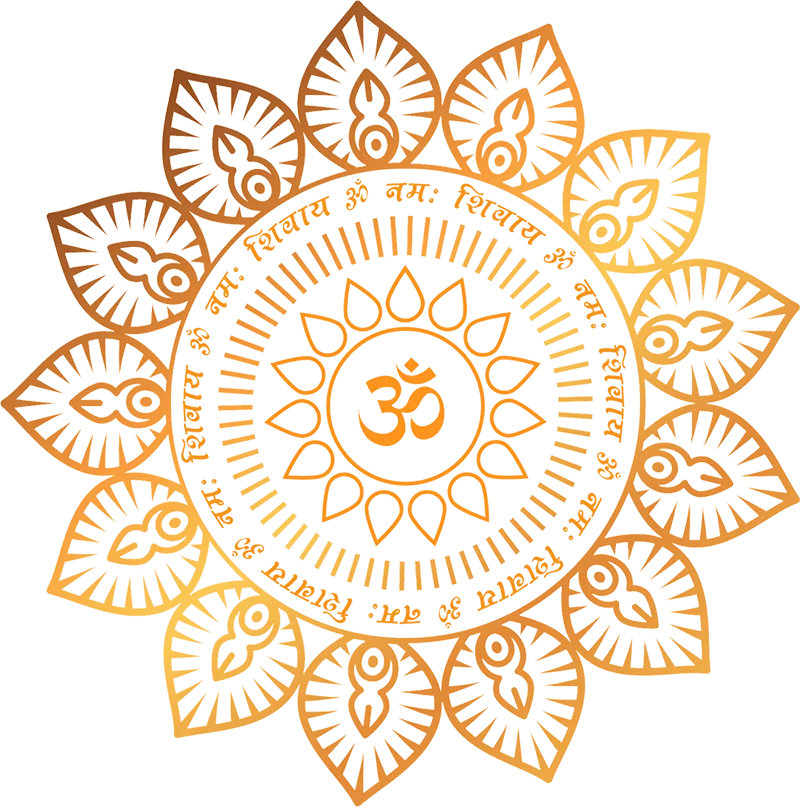
At Mira Yogashala, we believe that true learning flourishes in an environment of trust, inspiration, and shared passion. Our exceptional team of over 10 yoga gurus (masters) embodies these values, bringing a wealth of knowledge, experience, and dedication to their teaching. Each of our gurus is a registered yoga teacher with advanced certifications and years of experience guiding students from around the world. Many have deep roots in the traditional Himalayan yogic lineage, offering insights passed down through generations. We offer a warm, welcoming atmosphere where students and teachers connect on a personal level. Learning becomes a joyful exploration as you delve into the profound teachings of yoga, supported by our experienced and compassionate gurus.
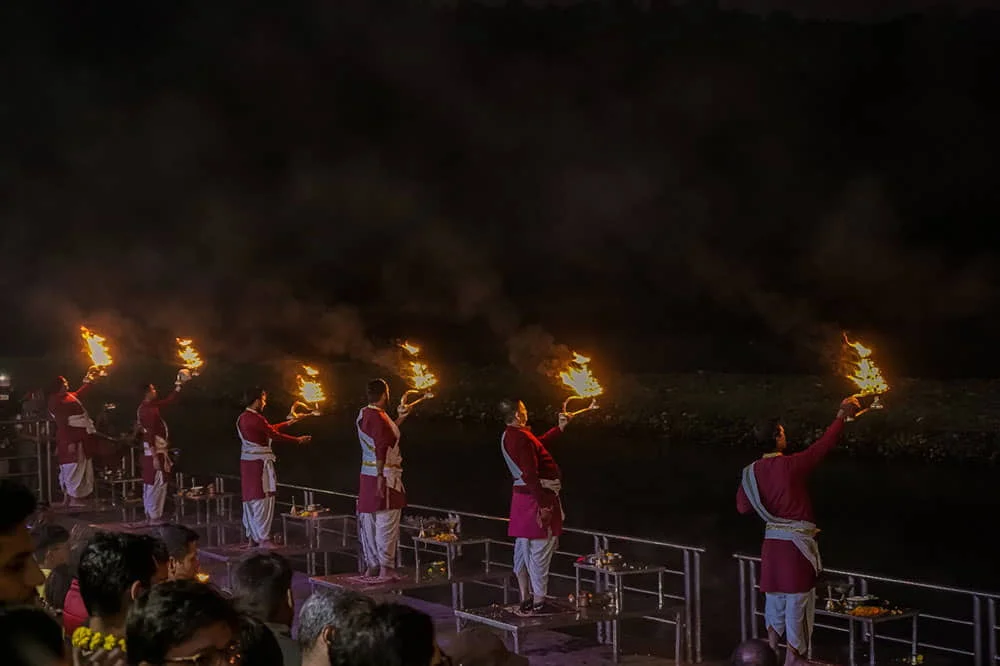
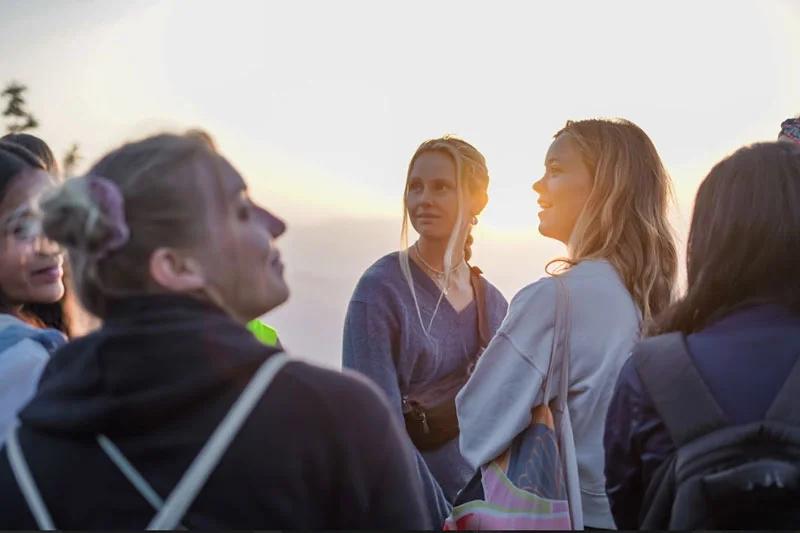
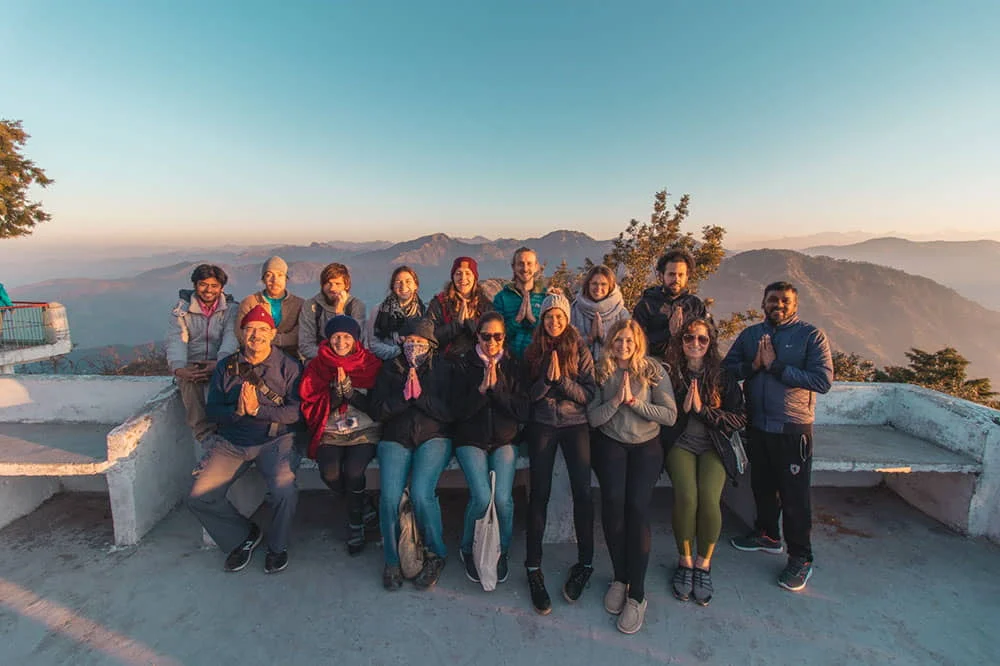


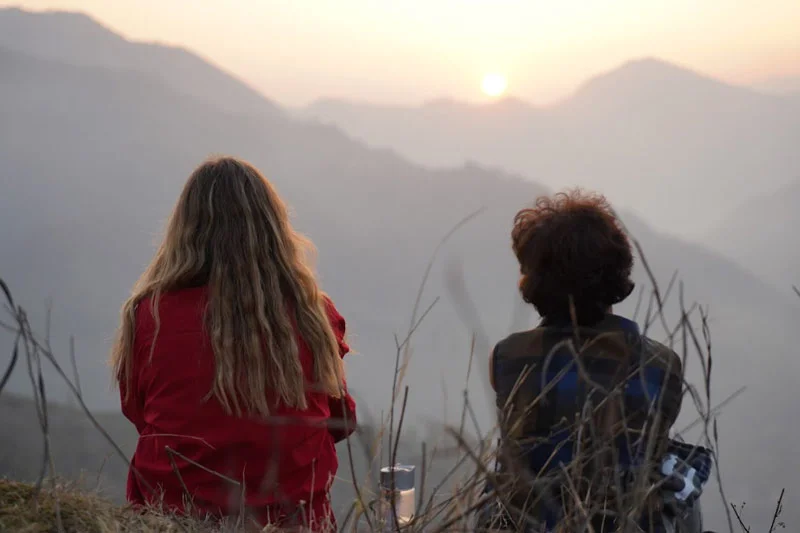
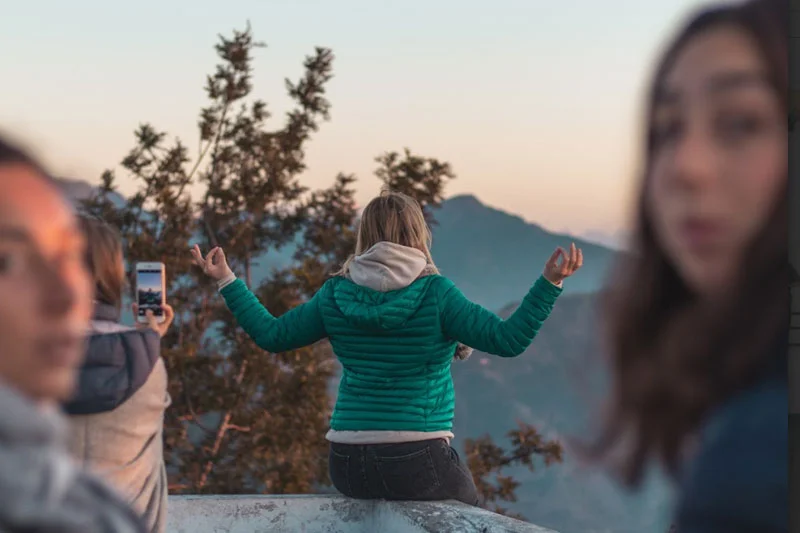
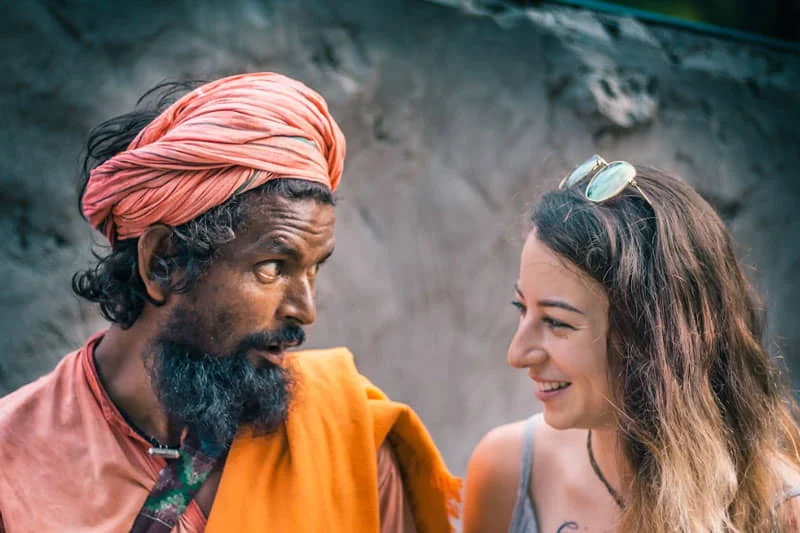
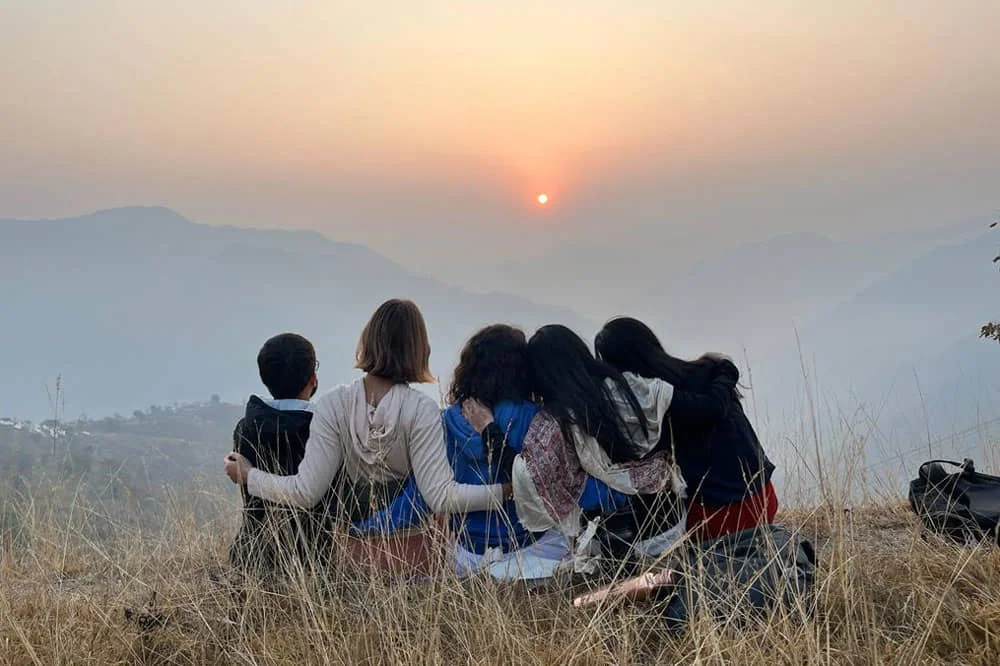
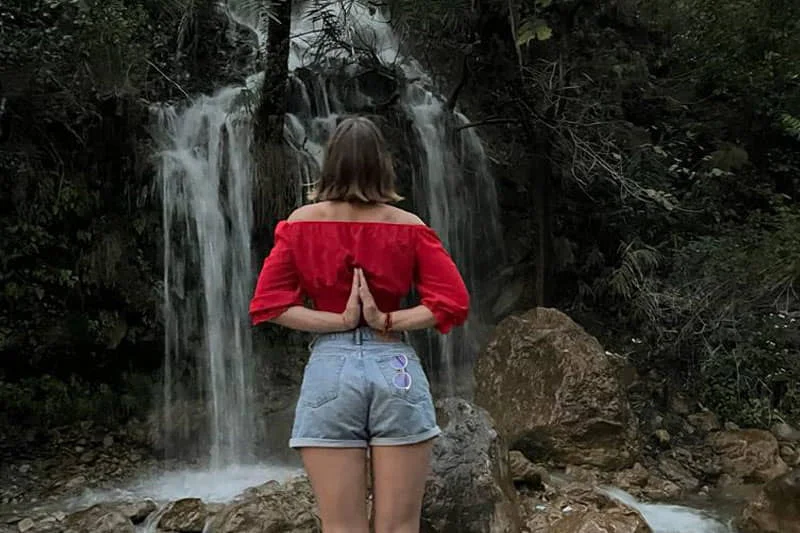
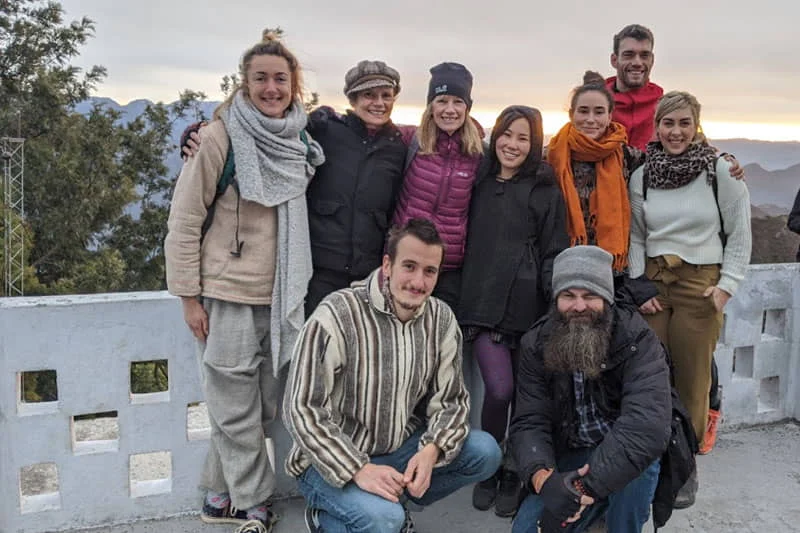
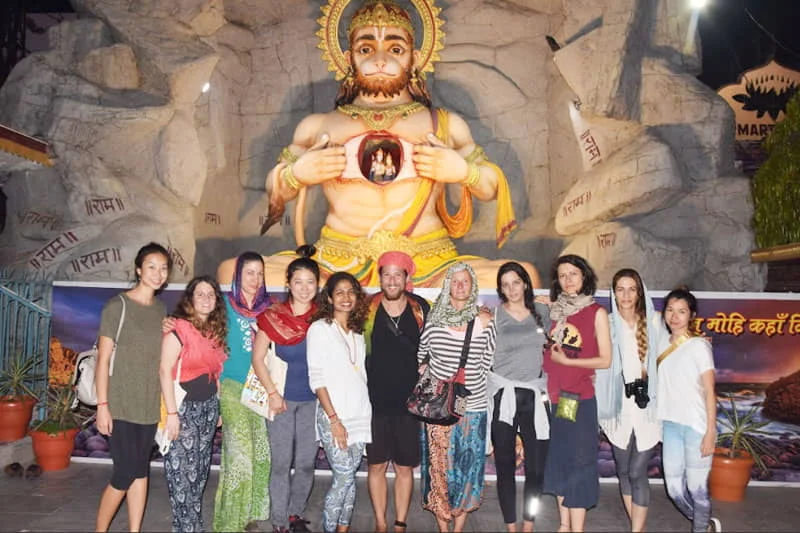

An excursion is an opportunity to go on an exciting experience that transcends the everyday, not just a way to break away from your daily classes. Whatever your interests, whether you are a nature lover, history buff, spiritual seeker, or just plain adventurer at heart, there's an adventure out there waiting to pique your curiosity and broaden your horizons. At Mira Yogashala, a truly enriching yoga experience extends beyond the boundaries of the School campus. That's why we provide you with an unforgettable and immersive experience at no extra cost when you choose us for your yoga yoga TTC. Our dedication to all-encompassing education includes exploring the natural and spiritual gems surrounding us in Rishikesh. You will have the chance to go on soul-enriching excursions to some of the most revered and breathtaking locations in the area while you are with us. During our Excursion we take you to quiet ashrams, historic temples, captivating waterfalls, and the fascinating Ganga Aarti ceremony. With our specially designed Himalayas sightseeing tour, you can even explore the magnificent Himalayas, witness the spectacular grandeur of sunrise vistas, and find peace in meditation caves. These trips are essential to your spiritual development and comprehension of the profound philosophy of yoga.
Our aim at Mira Yogashala is to ensure you have the most fulfilling yoga experience imaginable. We are proud and glad to offer these excursions as an integral part of your course. By fully immersing yourself in Rishikesh's rich cultural and natural legacy, you will improve your yoga practice, nourish your body, mind, and spirit, and make lifelong experiences that you will cherish long after your course is done.
We expect Yogic discipline and the required code of conduct from all students who join our course. Mira Yogashala has set specific disciplinary rules for all of its participants.
Our yoga school located in Rishikesh instructs us to follow the below-given policy guideline:-
![]() While we understand that plans can change, please be aware that your advance payment/deposit is non-refundable. However, we offer flexible options:
While we understand that plans can change, please be aware that your advance payment/deposit is non-refundable. However, we offer flexible options:
![]() Postpone Your Training: You can join us for the same training within the next year.
Postpone Your Training: You can join us for the same training within the next year.
![]() Transfer Your Spot: You're welcome to transfer your registration to someone else.
Transfer Your Spot: You're welcome to transfer your registration to someone else.
![]() We appreciate your understanding and look forward to welcoming you to Mira Yogashala !
We appreciate your understanding and look forward to welcoming you to Mira Yogashala !
Grow your knowledge and understanding of yoga with the following Outstanding books recommended by our Yoga instructors. These insightful Books will contribute to a comprehensive grasp of yoga principles and practices, expanding your overall knowledge of this ancient discipline.
Yes. Of course, Rishikesh Known as the Yoga Capital of the World. And it is the Origin place of Yoga. And it is always better to learn something from its Origin Place, because the knowledge you get from the origin place, you will not get from anywhere.
300 Hour Yoga TTC is an Advanced Yoga Course, Perfect course for you to Advanced Your Yogic knowledge. If you already completed 200 hour yoga ttc then only you are eligible to 300 hour yoga ttc.
Absolutely one will be certified As a Yoga Teacher After Course Completion and Mira Yogashala is a Registered Yoga Alliance School. So after getting 300 Hour TTC Certification, You are eligible to teach and open your Yoga Studio.
The Benefits of a 300 hour yoga teacher training course is that it will make your knowledge more advanced and vast about the yoga in theoretically and practically as well. You will learn Advanced Asanas practice, advanced Breathing Techniques, Ayurveda and Yoga therapy, and so much more in a short span of time.
Yes, You can Join this Course Because not everyone has an aim to become a Yoga Teacher. 90% Students Join this Course for their self improvement. The Knowledge you will Gain during 300 Hour Yoga TTC will benefit you throughout your lifetime.
As you want to prepare yourself for 300 hour yoga ttc, that means you have already completed 200 hour yoga ttc from an yoga alliance registered school. So you can go through what you learn in 200 hour yoga ttc so it will be easy for you to catch up with things more easily during your 300 hour yoga ttc at Mira Yogashala.


I had a wonderful experience at Mira Yoga School. We had a good instructor, clean rooms, and good food. All my teachers in the 300-hour yoga course did a fantastic job teaching us. I want to come back next year again.



I am from South Africa and I have completed my 200 hours Instructer's course at Mira Yogashala. It was a wonderful experience! It was very special because I did it with my daughter. We met amazing people and became like a family. The teachers are great and I learned a lot from them. All the staff are very friendly and helpful. This is an experience that I will never forget! Thank you Mira Yogashala for a life changing experience!!



I highly recommend Mira Yoga. The residence is in excellent conditions, an amazing view from the studio and the building. The building is in a quiet alley but a really good location in the city center. The course is amazing! The teachers are professional, a small group, and everything is at a very high level. The food is just wow! What stands out most about this place, is that they do not compromise on quality. I am so happy that I chose to do the 200 hour course at Mira Yoga, and thank the entire team for a month that I will never forget!



My experience at Mira Yoga Shala in Rishikesh for the 200-hour yoga instructor course was truly transformative. The teachers were exceptionally knowledgeable, patient, and passionate, creating an environment that was both challenging and nurturing. Each day brought a perfect blend of asanas, philosophy, pranayama, and meditation, which deepened my practice and understanding of yoga beyond the physical postures. The serene surroundings of Rishikesh, combined with the supportive community and family enviroment at the school, made it an unforgettable journey. I felt thoroughly prepared to teach with confidence and authenticity by the end of the course. I highly recommend Mira Yoga Shala to anyone looking to deepen their practice or begin their journey as a yoga teacher.



Mira Yogashala is home. The asharam is intimate and welcoming. The training is structured in a very rigorous way, like in a dance academy. And this gives you the opportunity to really breathe this wonderful discipline. The teachers are very prepared but the thing I appreciated the most was the great generosity they had in giving me their knowledge. I'm really grateful to be here🤍



Amazing experience!! It’s like being with family!! The small group size is perfect for me!! Full attention at all times!! Teachers are amazing!! All the kitchen staff are so lovely and accommodating!! I want to return for more training!! Thanks again Mira Yogashala ⭐️



Mira Yogashala.. Felt like family away from family , Nitesh took care of us like his own .safe environment. Very good teachers who guided us through the process , leraned a lot z Food was very delicious vegetarian, cook was awesome so caring he would make sure all of ate .. you will love it . Made lots of friend’s. Bonus actuvities like waterfalls, treckking.. Highly recommend I am so coming back for my 300 hours .. Wish u all the best for future.



I honestly had the best month here! The ashtanga and alignment teachers truly made this experience so enlightening! The food was so good I couldn't ever stop going back for more. All the staff here made me feel so supported in this journey, I can't recommend this place enough!



Great experience at Mira Yogashala. I have learned a lot from the magnificent teachers, I have also had a wonderful time with the activities we have done and I have also enjoyed the delicious dishes that the cooks have lovingly prepared every day. The place is spectacular, with impressive views of the mountains, the rooms are very comfortable and most importantly, the entire Mira Yogashala team has made me feel very loved. I feel happy and very grateful. Namaste 🙏🏽❤️



I had a great time staying at Mira yogashala. Vikas was incredible and so accommodating to us and so helpful. We had a few issues with circumstances outside of our control and Vikas did his best to help us. The location is great, out of Tapovan enough that isn't too loud but an easy and nice walk into town (check out French bakery for great coffees and delicious snacks). Teachers were good and had a lot of information and I left with a lot of knowledge but as can be expected it is a lot of information so you'll need some time after to absorb everything.


A place I wished I was here since born.. as I find the teachings in Mira yogashala was was an eye opener to what I was searching in life... the wisdom the philosophy the true purpose of yoga.. all the bits and pieces I knew became more enlightened when am here ..it’s a place to learn to be a true yogi within.. and the knowledge and wisdom is implanted with love... I took back a new seed that was planted within which am happy .. good to go and begin my life in order... and to share the knowledge with love and devotion...


I did the 200hr yoga teacher training course with Mira Yogashala during the month of July 2019. It has been an absolutely magical experience, which I even find challenging to describe in words. The team in Mira are extremely caring and careful to ensure their guests have their best time and all their needs are catered for - and they are great fun too :). The teachers are very, very knowledgeable, sharing with such openness, as well as listening with such openness. The food was the best ever - I absolutely fell in love with every single dish that the two cooks prepared and the variety was astonishing! I had a very peaceful, fulfilling and rewarding time with Mira Yogashala. I wholeheartedly recommend it and I look forward to returning over there.


The teachers were all knowledgeable and attentive to our needs, I have learned a lot about yoga Asanas, and also meditation and philosophy. Every single person that works in the school is fantastic and made the stay there so memorable. I really felt like home and really feel like we built our little yoga family there.The meals were mainly traditional indian dishes, tasty and fresh each day. The menu would vary every day and rarely the same dish was repeated. Most importantly not too spicy, but very tasty. The building itself was very new, hot water, fan in each room, wifi. The school was always clean in the communal area and we cleaned our own room and bathroom. The schedule allowed us to have some free time for studying and exploring Rishkesh as well. The school organized trips, to see the sunrise and to the Ganga beach. Everyone that worked in the school was fantastic: Anuji, my favorite teacher of them all taught me a lot about alignment and much more, every day I was looking forward for his classes. Deepak, morning classes were the perfect start of the day.Glenda, our mantra teacher changed completely my mind and idea of mantras.Anatomy, philosophy and meditation were as equally interesting as the yoga classes.Vikas, was both a teacher and a manager of the school. Last but not least, Romi, that took fantastic pictures, assured that everything would run smoothly and was always there in case you needed a hug.


Our group was small - just four of us, which was brilliant. It felt like being part of a big family - lots of teasing and fun, but also amazing support and caring. The teachers are very knowledgeable, skilled and competent, and the yoga teachers really push you to achieve optimum results. Very talented chef, clean rooms and building. Lots of local shops, cafes etc nearby


I would highly recommend Mira Yogashala. Although a young yoga school they don't look at their guests as clients, but as family. We grew so close to Sachin, Liubov, Vikas, Rahul, everyone! They are incredible people that take pride in what they do and care greatly for your experience. I learned so much during my month at Mira Yogashala, not only about Yoga, but about Indian culture, myself and what it means to be a good yoga teacher. I can't wait to return!


Mira Yogashala is more than just a yoga school, it's like a family. The teachers (as well as the rest of the staff) are all both passionate and knowledgable about their job, everyone of them is just wonderful. Very high quality standard of teaching. I learned so much during this month, more than I could have ever imagined! (And I'm not a total beginner). The food is delicious and the rooms are nice, hot water provided, and really good standard for India. Mira Yogashala feels like a home away from home, really. And Vikas is the golden soul that will always be there for you and take care of you, whatever you need. Thanks to him you will never feel lost. The school is also very responsive to feedback and puts really big effort in meeting your needs. This is extraordinary. From the bottom of my heart I can sincerely recommend you Mira Yogashala, you won't regret your choice.


I am extremely glad that I chose Mira Yogashala for yoga teacher training. The teachers are incredible, they are very knowledgable and good at sharing their knowledge. I learned so much during my month there, so much more than I could have ever imagined. I enjoyed every class, from morning hatha yoga to anatomy to philosophy and everything else. The training was very intense but also very rewarding, I felt that I developed a lot, both within yoga and as a person. I hope that many more people will get the chance to dive deeper into themselves and into the traditions of yoga at Mira Yogashala.


 Apply Now
Apply Now